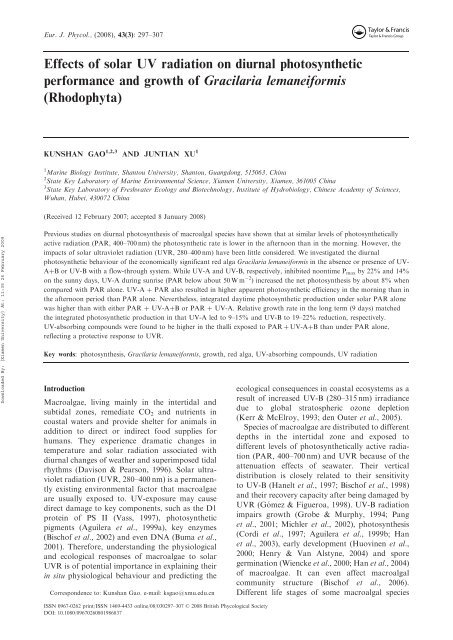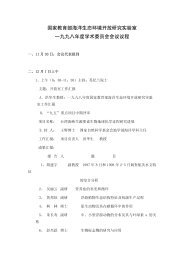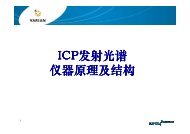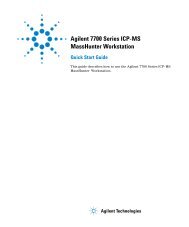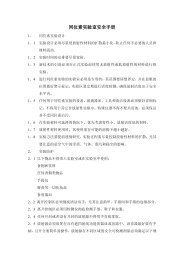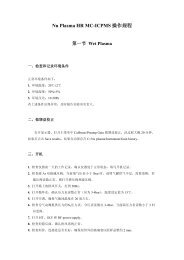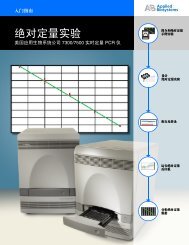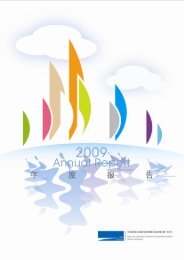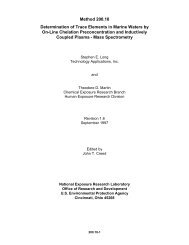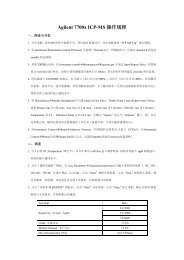Effects of solar UV radiation on diurnal photosynthetic performance ...
Effects of solar UV radiation on diurnal photosynthetic performance ...
Effects of solar UV radiation on diurnal photosynthetic performance ...
You also want an ePaper? Increase the reach of your titles
YUMPU automatically turns print PDFs into web optimized ePapers that Google loves.
Eur. J. Phycol., (2008), 43(3): 297–307<br />
<str<strong>on</strong>g>Effects</str<strong>on</strong>g> <str<strong>on</strong>g>of</str<strong>on</strong>g> <str<strong>on</strong>g>solar</str<strong>on</strong>g> <str<strong>on</strong>g>UV</str<strong>on</strong>g> <str<strong>on</strong>g>radiati<strong>on</strong></str<strong>on</strong>g> <strong>on</strong> <strong>diurnal</strong> <strong>photosynthetic</strong><br />
<strong>performance</strong> and growth <str<strong>on</strong>g>of</str<strong>on</strong>g> Gracilaria lemaneiformis<br />
(Rhodophyta)<br />
KUNSHAN GAO 1,2,3 AND JUNTIAN XU 1<br />
1 Marine Biology Institute, Shantou University, Shantou, Guangd<strong>on</strong>g, 515063, China<br />
2 State Key Laboratory <str<strong>on</strong>g>of</str<strong>on</strong>g> Marine Envir<strong>on</strong>mental Science, Xiamen University, Xiamen, 361005 China<br />
3 State Key Laboratory <str<strong>on</strong>g>of</str<strong>on</strong>g> Freshwater Ecology and Biotechnology, Institute <str<strong>on</strong>g>of</str<strong>on</strong>g> Hydrobiology, Chinese Academy <str<strong>on</strong>g>of</str<strong>on</strong>g> Sciences,<br />
Wuhan, Hubei, 430072 China<br />
(Received 12 February 2007; accepted 8 January 2008)<br />
Downloaded By: [Xiamen University] At: 11:35 26 February 2009<br />
Previous studies <strong>on</strong> <strong>diurnal</strong> photosynthesis <str<strong>on</strong>g>of</str<strong>on</strong>g> macroalgal species have shown that at similar levels <str<strong>on</strong>g>of</str<strong>on</strong>g> <strong>photosynthetic</strong>ally<br />
active <str<strong>on</strong>g>radiati<strong>on</strong></str<strong>on</strong>g> (PAR, 400–700 nm) the <strong>photosynthetic</strong> rate is lower in the afterno<strong>on</strong> than in the morning. However, the<br />
impacts <str<strong>on</strong>g>of</str<strong>on</strong>g> <str<strong>on</strong>g>solar</str<strong>on</strong>g> ultraviolet <str<strong>on</strong>g>radiati<strong>on</strong></str<strong>on</strong>g> (<str<strong>on</strong>g>UV</str<strong>on</strong>g>R, 280–400 nm) have been little c<strong>on</strong>sidered. We investigated the <strong>diurnal</strong><br />
<strong>photosynthetic</strong> behaviour <str<strong>on</strong>g>of</str<strong>on</strong>g> the ec<strong>on</strong>omically significant red alga Gracilaria lemaneiformis in the absence or presence <str<strong>on</strong>g>of</str<strong>on</strong>g> <str<strong>on</strong>g>UV</str<strong>on</strong>g>-<br />
AþB or <str<strong>on</strong>g>UV</str<strong>on</strong>g>-B with a flow-through system. While <str<strong>on</strong>g>UV</str<strong>on</strong>g>-A and <str<strong>on</strong>g>UV</str<strong>on</strong>g>-B, respectively, inhibited no<strong>on</strong>time P max by 22% and 14%<br />
<strong>on</strong> the sunny days, <str<strong>on</strong>g>UV</str<strong>on</strong>g>-A during sunrise (PAR below about 50 W m 2 ) increased the net photosynthesis by about 8% when<br />
compared with PAR al<strong>on</strong>e. <str<strong>on</strong>g>UV</str<strong>on</strong>g>-A þ PAR also resulted in higher apparent <strong>photosynthetic</strong> efficiency in the morning than in<br />
the afterno<strong>on</strong> period than PAR al<strong>on</strong>e. Nevertheless, integrated daytime <strong>photosynthetic</strong> producti<strong>on</strong> under <str<strong>on</strong>g>solar</str<strong>on</strong>g> PAR al<strong>on</strong>e<br />
was higher than with either PAR þ <str<strong>on</strong>g>UV</str<strong>on</strong>g>-AþB or PAR þ <str<strong>on</strong>g>UV</str<strong>on</strong>g>-A. Relative growth rate in the l<strong>on</strong>g term (9 days) matched<br />
the integrated <strong>photosynthetic</strong> producti<strong>on</strong> in that <str<strong>on</strong>g>UV</str<strong>on</strong>g>-A led to 9–15% and <str<strong>on</strong>g>UV</str<strong>on</strong>g>-B to 19–22% reducti<strong>on</strong>, respectively.<br />
<str<strong>on</strong>g>UV</str<strong>on</strong>g>-absorbing compounds were found to be higher in the thalli exposed to PAR þ <str<strong>on</strong>g>UV</str<strong>on</strong>g>-AþB than under PAR al<strong>on</strong>e,<br />
reflecting a protective resp<strong>on</strong>se to <str<strong>on</strong>g>UV</str<strong>on</strong>g>R.<br />
Key words: photosynthesis, Gracilaria lemaneiformis, growth, red alga, <str<strong>on</strong>g>UV</str<strong>on</strong>g>-absorbing compounds, <str<strong>on</strong>g>UV</str<strong>on</strong>g> <str<strong>on</strong>g>radiati<strong>on</strong></str<strong>on</strong>g><br />
Introducti<strong>on</strong><br />
Macroalgae, living mainly in the intertidal and<br />
subtidal z<strong>on</strong>es, remediate CO 2 and nutrients in<br />
coastal waters and provide shelter for animals in<br />
additi<strong>on</strong> to direct or indirect food supplies for<br />
humans. They experience dramatic changes in<br />
temperature and <str<strong>on</strong>g>solar</str<strong>on</strong>g> <str<strong>on</strong>g>radiati<strong>on</strong></str<strong>on</strong>g> associated with<br />
<strong>diurnal</strong> changes <str<strong>on</strong>g>of</str<strong>on</strong>g> weather and superimposed tidal<br />
rhythms (Davis<strong>on</strong> & Pears<strong>on</strong>, 1996). Solar ultraviolet<br />
<str<strong>on</strong>g>radiati<strong>on</strong></str<strong>on</strong>g> (<str<strong>on</strong>g>UV</str<strong>on</strong>g>R, 280–400 nm) is a permanently<br />
existing envir<strong>on</strong>mental factor that macroalgae<br />
are usually exposed to. <str<strong>on</strong>g>UV</str<strong>on</strong>g>-exposure may cause<br />
direct damage to key comp<strong>on</strong>ents, such as the D1<br />
protein <str<strong>on</strong>g>of</str<strong>on</strong>g> PS II (Vass, 1997), <strong>photosynthetic</strong><br />
pigments (Aguilera et al., 1999a), key enzymes<br />
(Bisch<str<strong>on</strong>g>of</str<strong>on</strong>g> et al., 2002) and even DNA (Buma et al.,<br />
2001). Therefore, understanding the physiological<br />
and ecological resp<strong>on</strong>ses <str<strong>on</strong>g>of</str<strong>on</strong>g> macroalgae to <str<strong>on</strong>g>solar</str<strong>on</strong>g><br />
<str<strong>on</strong>g>UV</str<strong>on</strong>g>R is <str<strong>on</strong>g>of</str<strong>on</strong>g> potential importance in explaining their<br />
in situ physiological behaviour and predicting the<br />
Corresp<strong>on</strong>dence to: Kunshan Gao. e-mail: ksgao@xmu.edu.cn<br />
ecological c<strong>on</strong>sequences in coastal ecosystems as a<br />
result <str<strong>on</strong>g>of</str<strong>on</strong>g> increased <str<strong>on</strong>g>UV</str<strong>on</strong>g>-B (280–315 nm) irradiance<br />
due to global stratospheric oz<strong>on</strong>e depleti<strong>on</strong><br />
(Kerr & McElroy, 1993; den Outer et al., 2005).<br />
Species <str<strong>on</strong>g>of</str<strong>on</strong>g> macroalgae are distributed to different<br />
depths in the intertidal z<strong>on</strong>e and exposed to<br />
different levels <str<strong>on</strong>g>of</str<strong>on</strong>g> <strong>photosynthetic</strong>ally active <str<strong>on</strong>g>radiati<strong>on</strong></str<strong>on</strong>g><br />
(PAR, 400–700 nm) and <str<strong>on</strong>g>UV</str<strong>on</strong>g>R because <str<strong>on</strong>g>of</str<strong>on</strong>g> the<br />
attenuati<strong>on</strong> effects <str<strong>on</strong>g>of</str<strong>on</strong>g> seawater. Their vertical<br />
distributi<strong>on</strong> is closely related to their sensitivity<br />
to <str<strong>on</strong>g>UV</str<strong>on</strong>g>-B (Hanelt et al., 1997; Bisch<str<strong>on</strong>g>of</str<strong>on</strong>g> et al., 1998)<br />
and their recovery capacity after being damaged by<br />
<str<strong>on</strong>g>UV</str<strong>on</strong>g>R (Go´mez & Figueroa, 1998). <str<strong>on</strong>g>UV</str<strong>on</strong>g>-B <str<strong>on</strong>g>radiati<strong>on</strong></str<strong>on</strong>g><br />
impairs growth (Grobe & Murphy, 1994; Pang<br />
et al., 2001; Michler et al., 2002), photosynthesis<br />
(Cordi et al., 1997; Aguilera et al., 1999b; Han<br />
et al., 2003), early development (Huovinen et al.,<br />
2000; Henry & Van Alstyne, 2004) and spore<br />
germinati<strong>on</strong> (Wiencke et al., 2000; Han et al., 2004)<br />
<str<strong>on</strong>g>of</str<strong>on</strong>g> macroalgae. It can even affect macroalgal<br />
community structure (Bisch<str<strong>on</strong>g>of</str<strong>on</strong>g> et al., 2006).<br />
Different life stages <str<strong>on</strong>g>of</str<strong>on</strong>g> some macroalgal species<br />
ISSN 0967-0262 print/ISSN 1469-4433 <strong>on</strong>line/08/030297–307 ß 2008 British Phycological Society<br />
DOI: 10.1080/09670260801986837
K. Gao & J. Xu 298<br />
Downloaded By: [Xiamen University] At: 11:35 26 February 2009<br />
showed different abilities to endure <str<strong>on</strong>g>UV</str<strong>on</strong>g>R, with<br />
increased tolerance as individuals differentiate and<br />
develop repair and defence capacity (Dring et al.,<br />
1996; Henry & Van Alstyne, 2004).<br />
Macroalgae can protect themselves from being<br />
harmed by <str<strong>on</strong>g>UV</str<strong>on</strong>g>R, or diminish the damage, by<br />
avoidance, repair and screening mechanisms<br />
(Karentz, 1994; Franklin & Forster, 1997;<br />
Karentz, 2001). <str<strong>on</strong>g>UV</str<strong>on</strong>g>-screening compounds, such<br />
as mycosporine-like amino acids (Karentz et al.,<br />
1991; Dunlap & Shick, 1998), scyt<strong>on</strong>emin (Garcia-<br />
Pichel & Castenholz, 1991; Dill<strong>on</strong> et al., 2002) and<br />
phlorotannins (Pavia et al., 1997; Pavia & Brock,<br />
2000) have been found in many <strong>photosynthetic</strong><br />
organisms. Cellular c<strong>on</strong>tent <str<strong>on</strong>g>of</str<strong>on</strong>g> these compounds<br />
increase with increased <str<strong>on</strong>g>UV</str<strong>on</strong>g> exposure (Pavia et al.,<br />
1997; Brenowitz & Castenholz, 1997; Han & Han,<br />
2005) thereby reducing <str<strong>on</strong>g>UV</str<strong>on</strong>g>-related photoinhibiti<strong>on</strong><br />
and damage.<br />
Despite a number <str<strong>on</strong>g>of</str<strong>on</strong>g> studies dem<strong>on</strong>strating the<br />
deleterious effects <str<strong>on</strong>g>of</str<strong>on</strong>g> <str<strong>on</strong>g>UV</str<strong>on</strong>g>-B <strong>on</strong> macroalgae,<br />
researches also show that <str<strong>on</strong>g>solar</str<strong>on</strong>g> <str<strong>on</strong>g>UV</str<strong>on</strong>g>-B <str<strong>on</strong>g>radiati<strong>on</strong></str<strong>on</strong>g><br />
could play a role in the recovery process <str<strong>on</strong>g>of</str<strong>on</strong>g><br />
inhibited photosynthesis in a brown alga,<br />
Dictyota dichotoma (Flores-Moya et al., 1999),<br />
and some freshwater plants (Hanelt et al., 2006),<br />
and that <str<strong>on</strong>g>UV</str<strong>on</strong>g>-A (315–400 nm) <str<strong>on</strong>g>radiati<strong>on</strong></str<strong>on</strong>g> could aid<br />
in DNA repair (Pakker et al., 2000a,b) and<br />
enhance growth (Henry & Van Alstyne, 2004) in<br />
macroalgae. Dring et al. (2001) reported higher<br />
maximum quantum yields in several subtidal red<br />
algae during recovery after exposure to <str<strong>on</strong>g>solar</str<strong>on</strong>g> <str<strong>on</strong>g>UV</str<strong>on</strong>g>-A<br />
or <str<strong>on</strong>g>UV</str<strong>on</strong>g>-A þ <str<strong>on</strong>g>UV</str<strong>on</strong>g>-B in the absence <str<strong>on</strong>g>of</str<strong>on</strong>g> PAR as<br />
compared with the exposures to PAR al<strong>on</strong>e or<br />
PAR þ <str<strong>on</strong>g>UV</str<strong>on</strong>g>R, suggesting that <str<strong>on</strong>g>UV</str<strong>on</strong>g>R was less<br />
damaging to photosynthesis than high PAR <str<strong>on</strong>g>of</str<strong>on</strong>g><br />
natural sunlight. On the other hand, in c<strong>on</strong>trast to<br />
the impacts <str<strong>on</strong>g>of</str<strong>on</strong>g> <str<strong>on</strong>g>UV</str<strong>on</strong>g>R in short-term experiments,<br />
hardly any lasting difference was found in growth<br />
between samples exposed to <str<strong>on</strong>g>solar</str<strong>on</strong>g> <str<strong>on</strong>g>radiati<strong>on</strong></str<strong>on</strong>g> with or<br />
without <str<strong>on</strong>g>UV</str<strong>on</strong>g>-B in l<strong>on</strong>g-term experiments <strong>on</strong> Ulva<br />
rigida (Altamirano et al., 2000) and Fucus serratus<br />
(Michler et al., 2002). Nevertheless, <str<strong>on</strong>g>UV</str<strong>on</strong>g>R was<br />
found to affect the growth in l<strong>on</strong>g-term and field<br />
experiments <strong>on</strong> Laminaria spp (Michler et al.,<br />
2002; Roleda et al., 2006). Despite a number <str<strong>on</strong>g>of</str<strong>on</strong>g><br />
studies <strong>on</strong> the negative and positive effects <str<strong>on</strong>g>of</str<strong>on</strong>g><br />
<str<strong>on</strong>g>UV</str<strong>on</strong>g>R, little has been documented <strong>on</strong> the <strong>diurnal</strong><br />
<strong>photosynthetic</strong> <strong>performance</strong> associated with fluctuating<br />
<str<strong>on</strong>g>solar</str<strong>on</strong>g> <str<strong>on</strong>g>UV</str<strong>on</strong>g>R and PAR. Informati<strong>on</strong> about<br />
<strong>diurnal</strong> physiological behaviour under the full<br />
spectrum <str<strong>on</strong>g>of</str<strong>on</strong>g> <str<strong>on</strong>g>solar</str<strong>on</strong>g> <str<strong>on</strong>g>radiati<strong>on</strong></str<strong>on</strong>g> is essential for us to<br />
understand the daytime <str<strong>on</strong>g>UV</str<strong>on</strong>g>R impacts associated<br />
with changing <str<strong>on</strong>g>solar</str<strong>on</strong>g> <str<strong>on</strong>g>radiati<strong>on</strong></str<strong>on</strong>g> and to explain the<br />
difference in macroalgal resp<strong>on</strong>ses to <str<strong>on</strong>g>UV</str<strong>on</strong>g>R<br />
between short and l<strong>on</strong>g-term experiments.<br />
The aim <str<strong>on</strong>g>of</str<strong>on</strong>g> the present study was to elucidate the<br />
impacts <str<strong>on</strong>g>of</str<strong>on</strong>g> <str<strong>on</strong>g>solar</str<strong>on</strong>g> <str<strong>on</strong>g>UV</str<strong>on</strong>g>-B, <str<strong>on</strong>g>UV</str<strong>on</strong>g>-A and PAR <strong>on</strong> the<br />
<strong>diurnal</strong> <strong>photosynthetic</strong> <strong>performance</strong> and growth <str<strong>on</strong>g>of</str<strong>on</strong>g><br />
the ec<strong>on</strong>omically important red alga, Gracilaria<br />
lemaneiformis Bory, which is commercially cultivated<br />
in surface water for food and agar around<br />
the coast <str<strong>on</strong>g>of</str<strong>on</strong>g> China.<br />
Materials and methods<br />
Plant materials<br />
Gracilaria lemaneiformis, is naturally distributed in the<br />
sublittoral z<strong>on</strong>e in northern part <str<strong>on</strong>g>of</str<strong>on</strong>g> China, and has been<br />
farmed for years in coastal surface water from<br />
November to May in southern China. Plants were<br />
collected from their cultivati<strong>on</strong> area where they were<br />
grown at a depth <str<strong>on</strong>g>of</str<strong>on</strong>g> 0.5–1 m at Nanao (116.6 E,<br />
23.3 N), Shantou, China, in March, April and May,<br />
2004, or from a farmed populati<strong>on</strong> in the coastal water<br />
near Qingdao (120 E, 36 N) in September, 2006.<br />
Seawater temperature ranged from 16 to 28 C during<br />
the periods <str<strong>on</strong>g>of</str<strong>on</strong>g> March, April and May, 2004, and was<br />
c<strong>on</strong>trolled at 22 0.5 C for the experiments during<br />
September, 2006. The nitrate and phosphate c<strong>on</strong>centrati<strong>on</strong>s<br />
ranged from 41–43 mM and 0.56–0.62 mM respectively<br />
during this seas<strong>on</strong>. The maximal incident<br />
irradiances received by the thalli in the farmed area<br />
were about 1.2 W m 2 for <str<strong>on</strong>g>UV</str<strong>on</strong>g>-B, 40 W m 2 for <str<strong>on</strong>g>UV</str<strong>on</strong>g>-A<br />
and 400 W m 2 for PAR. Young plants (about 20 cm<br />
l<strong>on</strong>g) were selected and maintained in sand-filtered<br />
flowing seawater for a night before their <strong>diurnal</strong><br />
photosynthesis was measured next day. For experiments<br />
in the September, the plants were transported (in a<br />
cooler) from Qingdao and cultured indoors at 15 W m 2<br />
PAR and 22 C for 7 days, and then exposed to <str<strong>on</strong>g>solar</str<strong>on</strong>g><br />
<str<strong>on</strong>g>radiati<strong>on</strong></str<strong>on</strong>g> at the same temperature (to simulate that in<br />
April) for another 7 days prior to measuring <str<strong>on</strong>g>of</str<strong>on</strong>g> <strong>diurnal</strong><br />
photosynthesis.<br />
Solar <str<strong>on</strong>g>radiati<strong>on</strong></str<strong>on</strong>g> measurements and treatments<br />
Incident <str<strong>on</strong>g>solar</str<strong>on</strong>g> irradiance was c<strong>on</strong>tinuously m<strong>on</strong>itored<br />
using an ELDONET filter radiometer (Real Time<br />
Computer, Mo¨hrendorf, Germany), which has three<br />
channels for <strong>photosynthetic</strong>ally active <str<strong>on</strong>g>radiati<strong>on</strong></str<strong>on</strong>g> (PAR,<br />
400–700 nm), <str<strong>on</strong>g>UV</str<strong>on</strong>g>-A (<str<strong>on</strong>g>UV</str<strong>on</strong>g>-A, 315–400 nm) and <str<strong>on</strong>g>UV</str<strong>on</strong>g>-B<br />
<str<strong>on</strong>g>radiati<strong>on</strong></str<strong>on</strong>g> (<str<strong>on</strong>g>UV</str<strong>on</strong>g>-B, 280–315 nm). The reliability <str<strong>on</strong>g>of</str<strong>on</strong>g> this<br />
instrument has been internati<strong>on</strong>ally recognised (Ha¨der<br />
et al., 1999; Korbee-Peinado et al., 2004), and certificated<br />
with a corresp<strong>on</strong>dence error less than 0.5% in<br />
comparis<strong>on</strong> with the most accurate instrument (certificate<br />
No. 2006/BB14/1). The device was installed <strong>on</strong> the<br />
ro<str<strong>on</strong>g>of</str<strong>on</strong>g> <str<strong>on</strong>g>of</str<strong>on</strong>g> the Nan’ao Marine Biological Stati<strong>on</strong> <str<strong>on</strong>g>of</str<strong>on</strong>g><br />
Shantou University where the experiments were carried<br />
out. Three different <str<strong>on</strong>g>radiati<strong>on</strong></str<strong>on</strong>g> treatments were implemented<br />
as follows: thalli receiving full <str<strong>on</strong>g>solar</str<strong>on</strong>g> <str<strong>on</strong>g>radiati<strong>on</strong></str<strong>on</strong>g><br />
(PAB treatment) in uncovered quartz tubes; thalli<br />
receiving <str<strong>on</strong>g>UV</str<strong>on</strong>g>-A and PAR (PA treatment) in quartz<br />
tubes covered with Folex 320 (M<strong>on</strong>tagefolie, Nr<br />
10155099, Folex, Dreieich, Germany); and thalli receiving<br />
<strong>on</strong>ly PAR (P treatment) in quartz tubes covered with<br />
Ultraphan film 395 (<str<strong>on</strong>g>UV</str<strong>on</strong>g> Opak, Digefra, Munich,<br />
Germany). The transmissi<strong>on</strong> spectra <str<strong>on</strong>g>of</str<strong>on</strong>g> the cut-<str<strong>on</strong>g>of</str<strong>on</strong>g>f filters
<str<strong>on</strong>g>Effects</str<strong>on</strong>g> <str<strong>on</strong>g>of</str<strong>on</strong>g> <str<strong>on</strong>g>UV</str<strong>on</strong>g> <str<strong>on</strong>g>radiati<strong>on</strong></str<strong>on</strong>g> <strong>on</strong> Gracilaria <strong>diurnal</strong> photosynthesis 299<br />
with negligible reflecti<strong>on</strong> have been published elsewhere<br />
(Korbee-Peinado et al., 2004). The uncovered quartz<br />
tubes received 4% higher PAR <str<strong>on</strong>g>radiati<strong>on</strong></str<strong>on</strong>g> (measured by<br />
inserting a PAR sensor inside the quartz c<strong>on</strong>tainer)<br />
compared with the covered tubes with the 395 or 320<br />
filters due to the reflecti<strong>on</strong> (in water) caused by these<br />
filters.<br />
Seawater<br />
Flowmeter<br />
PAR+<str<strong>on</strong>g>UV</str<strong>on</strong>g>−A+<str<strong>on</strong>g>UV</str<strong>on</strong>g>−B<br />
PAR+<str<strong>on</strong>g>UV</str<strong>on</strong>g>−A<br />
PAR<br />
Quartz tube<br />
Oxygen m<strong>on</strong>itor<br />
Downloaded By: [Xiamen University] At: 11:35 26 February 2009<br />
Diurnal photosynthesis measurement<br />
A flow-through system for measuring photosynthesis in<br />
running water was set up according to Gao & Umezaki<br />
(1989) (Fig. 1). Quartz tubes (4 cm inner diameter and<br />
35 cm l<strong>on</strong>g, 0.44 l) were used as assimilati<strong>on</strong> chambers to<br />
allow the full spectrum <str<strong>on</strong>g>of</str<strong>on</strong>g> <str<strong>on</strong>g>solar</str<strong>on</strong>g> <str<strong>on</strong>g>radiati<strong>on</strong></str<strong>on</strong>g> to reach the<br />
thalli inside. The flow rate <str<strong>on</strong>g>of</str<strong>on</strong>g> seawater was c<strong>on</strong>trolled at<br />
0.2 l min 1 by a flow meter. Although current speed may<br />
affect <strong>photosynthetic</strong> O 2 evoluti<strong>on</strong> (Wheeler, 1980; Gao<br />
et al., 1992), this flow rate resulted in the best resoluti<strong>on</strong><br />
and avoided the bottle effects incurred with still sealed<br />
seawater. It took about 5 min for the O 2 c<strong>on</strong>centrati<strong>on</strong><br />
in the outlet seawater to reach a c<strong>on</strong>stant level when the<br />
thalli photosynthesized under c<strong>on</strong>stant levels <str<strong>on</strong>g>of</str<strong>on</strong>g> PAR or<br />
sunlight. Oxygen c<strong>on</strong>centrati<strong>on</strong>s in the inlet and outlet<br />
seawater were m<strong>on</strong>itored simultaneously and c<strong>on</strong>tinuously<br />
with a Clark-type oxygen electrode probe (YSI<br />
model 5300, Yellow Spring, OH, USA), which was<br />
calibrated every day at the early morning and at midday,<br />
when the seawater temperature changed by about 1 C.<br />
Between six and 10 branches from different individuals<br />
were placed in the quartz tube by fixing them <strong>on</strong><br />
stainless steel wires with the biomass density (fresh<br />
weight [FW] <str<strong>on</strong>g>of</str<strong>on</strong>g> about 270 g m 2 , which did not result in<br />
self-shading [biomass density was 100–5,000 g m 2 in the<br />
farmed areas]. The rate <str<strong>on</strong>g>of</str<strong>on</strong>g> <strong>photosynthetic</strong> O 2 evoluti<strong>on</strong><br />
[P, mmol O 2 g 1 h 1 ] was determined as follows:<br />
P ¼ (A–B) F 60 W 1 , where A and B represent dissolved<br />
O 2 c<strong>on</strong>centrati<strong>on</strong>s (mmol O 2 l<br />
1 ) in the outlet and<br />
inlet seawater, respectively; F, the flow rate (L min 1 )<str<strong>on</strong>g>of</str<strong>on</strong>g><br />
seawater; W, fresh weight (g) <str<strong>on</strong>g>of</str<strong>on</strong>g> the samples used.<br />
Parameters for photosynthesis–light (P–E) curves were<br />
analysed according to Jassby & Platt (1976):<br />
P ¼ P max tanh( E/P max ) þ Rd, where P represents<br />
<strong>photosynthetic</strong> rate; E, irradiance, P max , the lightsaturated<br />
<strong>photosynthetic</strong> rate; , initial slope at limiting<br />
irradiances and, Rd, the dark respirati<strong>on</strong> rate.<br />
Since the uncovered quartz c<strong>on</strong>tainers received 4%<br />
higher PAR than those covered with the cut-<str<strong>on</strong>g>of</str<strong>on</strong>g>f filters<br />
either under low or high levels <str<strong>on</strong>g>of</str<strong>on</strong>g> <str<strong>on</strong>g>solar</str<strong>on</strong>g> <str<strong>on</strong>g>radiati<strong>on</strong></str<strong>on</strong>g> and this<br />
higher porti<strong>on</strong> <str<strong>on</strong>g>of</str<strong>on</strong>g> PAR might affect the comparis<strong>on</strong> <str<strong>on</strong>g>of</str<strong>on</strong>g><br />
irradiance-limiting <strong>photosynthetic</strong> rate with or without<br />
<str<strong>on</strong>g>UV</str<strong>on</strong>g>R, PAR values were calibrated by multiplying 0.96<br />
for the P-E curves obtained without <str<strong>on</strong>g>UV</str<strong>on</strong>g>R. In order to<br />
estimate the daily net <strong>photosynthetic</strong> producti<strong>on</strong>, daytime<br />
net photosynthesis expressed (mmol O 2 ) was<br />
c<strong>on</strong>verted to dry matter using the ratio <str<strong>on</strong>g>of</str<strong>on</strong>g> 1 g O 2 to<br />
0.84 g dry matter (Ikusima, 1965).<br />
To estimate the <strong>diurnal</strong> <strong>photosynthetic</strong> <strong>performance</strong><br />
<strong>on</strong> a cloudy day in April, we simulated the weather<br />
c<strong>on</strong>diti<strong>on</strong>s for April 24, 2004 <strong>on</strong> September 29, 2006<br />
(unexpected high <strong>photosynthetic</strong> rates were obtained in<br />
the presence <str<strong>on</strong>g>of</str<strong>on</strong>g> <str<strong>on</strong>g>UV</str<strong>on</strong>g>-A) by reducing the <strong>diurnal</strong> <str<strong>on</strong>g>solar</str<strong>on</strong>g><br />
Fig. 1. Outline <str<strong>on</strong>g>of</str<strong>on</strong>g> the flow-through system used for<br />
measuring the <strong>diurnal</strong> photosynthesis <str<strong>on</strong>g>of</str<strong>on</strong>g> Gracilaria<br />
lemaneiformis. Quartz tubes were used as the assimilati<strong>on</strong><br />
chamber. Thalli in the tubes were exposed to different <str<strong>on</strong>g>solar</str<strong>on</strong>g><br />
<str<strong>on</strong>g>radiati<strong>on</strong></str<strong>on</strong>g> treatments by using <str<strong>on</strong>g>UV</str<strong>on</strong>g>-cutting <str<strong>on</strong>g>of</str<strong>on</strong>g>f filters.<br />
<str<strong>on</strong>g>radiati<strong>on</strong></str<strong>on</strong>g> with black plastic neutral screens and c<strong>on</strong>trolling<br />
the temperature at 22 0.5 C using a cooling unit<br />
(CAP-3000, Rikakikai, Tokyo, Japan).<br />
Measurements <str<strong>on</strong>g>of</str<strong>on</strong>g> growth<br />
Thalli <str<strong>on</strong>g>of</str<strong>on</strong>g> about 2 g FW were maintained in the flowthrough<br />
seawater in each <str<strong>on</strong>g>of</str<strong>on</strong>g> the quartz tubes with a<br />
biomass density <str<strong>on</strong>g>of</str<strong>on</strong>g> about 100 g m 2 FW (without selfshading)<br />
at the same flow rate (0.2 l min 1 ) as menti<strong>on</strong>ed<br />
above for photosynthesis measurements. The growth<br />
experiments were run separately from the <strong>photosynthetic</strong><br />
experiments (with different samples) for 9 days:<br />
April 9–17 and May 13–20, 2004. FW <str<strong>on</strong>g>of</str<strong>on</strong>g> the thalli was<br />
measured every 2 days after blotting with tissue paper,<br />
and relative growth rate (RGR,% day 1 ) was estimated<br />
as follows: RGR ¼ 100 (lnN t –lnN 0 )/t, where N 0 is the<br />
initial FW and N t that after t number <str<strong>on</strong>g>of</str<strong>on</strong>g> days.<br />
Determinati<strong>on</strong> <str<strong>on</strong>g>of</str<strong>on</strong>g> <strong>photosynthetic</strong> pigments<br />
and <str<strong>on</strong>g>UV</str<strong>on</strong>g>-absorbing compounds<br />
The samples for pigment analyses were stored at –20 C.<br />
About 200 mg (FW) thalli were extracted in 10 ml<br />
absolute methanol for 24 h at 4 C in darkness, which<br />
resulted in complete extracti<strong>on</strong>. After centrifugati<strong>on</strong> at<br />
5,000 g for 10 min this extract was used to determine the<br />
amounts <str<strong>on</strong>g>of</str<strong>on</strong>g> <str<strong>on</strong>g>UV</str<strong>on</strong>g>-absorbing compounds (<str<strong>on</strong>g>UV</str<strong>on</strong>g>AC) and<br />
<strong>photosynthetic</strong> pigments using a scanning spectrophotometer<br />
(<str<strong>on</strong>g>UV</str<strong>on</strong>g> 530, Beckman Coulter, Fullert<strong>on</strong>, CA,<br />
USA). The <str<strong>on</strong>g>UV</str<strong>on</strong>g>AC c<strong>on</strong>tent was estimated by determining<br />
the ratio <str<strong>on</strong>g>of</str<strong>on</strong>g> <str<strong>on</strong>g>UV</str<strong>on</strong>g>AC to chlorophyll a (Chl a)<br />
according to Dunlap et al. (1995) and c<strong>on</strong>verting the<br />
ratio to c<strong>on</strong>tent per FW. Chl a c<strong>on</strong>centrati<strong>on</strong> was<br />
estimated according to Wellburn (1994).<br />
Data treatment and statistic analysis<br />
Diurnal <strong>photosynthetic</strong> rates were related to <str<strong>on</strong>g>solar</str<strong>on</strong>g><br />
irradiance to generate photosynthesis versus light<br />
curves, and were integrated to estimate daily net<br />
producti<strong>on</strong>. <str<strong>on</strong>g>UV</str<strong>on</strong>g>R, <str<strong>on</strong>g>UV</str<strong>on</strong>g>-A or <str<strong>on</strong>g>UV</str<strong>on</strong>g>-B-induced inhibiti<strong>on</strong><br />
was obtained as follows: (P PAR –P PAB )/P PAR 100%,<br />
(P PAR –P PA )/P PAR 100% or (P PA –P PAB )/P PAR 100%,<br />
where P PAB , P PA and P PAR represent the net
K. Gao & J. Xu 300<br />
<strong>photosynthetic</strong> rates under the treatments <str<strong>on</strong>g>of</str<strong>on</strong>g> PAR þ<br />
<str<strong>on</strong>g>UV</str<strong>on</strong>g>-AþB, PAR þ <str<strong>on</strong>g>UV</str<strong>on</strong>g>-A or PAR al<strong>on</strong>e, respectively.<br />
ANOVA and t-test were used to establish differences<br />
am<strong>on</strong>g the different treatments. A c<strong>on</strong>fidence level <str<strong>on</strong>g>of</str<strong>on</strong>g><br />
95% was used in all analyses.<br />
Results<br />
Diurnal <strong>photosynthetic</strong> <strong>performance</strong> <str<strong>on</strong>g>of</str<strong>on</strong>g> Gracilaria<br />
lemaneiformis in March, April (1-day simulated in<br />
September and May showed that daytime photosynthesis<br />
almost followed the pattern <str<strong>on</strong>g>of</str<strong>on</strong>g> sunlight<br />
regardless <str<strong>on</strong>g>of</str<strong>on</strong>g> the <str<strong>on</strong>g>solar</str<strong>on</strong>g> <str<strong>on</strong>g>radiati<strong>on</strong></str<strong>on</strong>g> treatment, increasing<br />
and becoming saturated with increased <str<strong>on</strong>g>solar</str<strong>on</strong>g><br />
irradiance in the morning, and declining with<br />
decreasing <str<strong>on</strong>g>solar</str<strong>on</strong>g> <str<strong>on</strong>g>radiati<strong>on</strong></str<strong>on</strong>g> in the afterno<strong>on</strong><br />
(Fig. 2). On April 20, which was cloudless, net<br />
<strong>photosynthetic</strong> rate decreased c<strong>on</strong>tinuously from<br />
morning to afterno<strong>on</strong>, showing clear photoinhibiti<strong>on</strong><br />
during the <strong>diurnal</strong> course. Photosynthetic O 2<br />
evoluti<strong>on</strong> was inhibited in thalli receiving the full<br />
spectrum <str<strong>on</strong>g>of</str<strong>on</strong>g> sunlight (PAB treatment) or PAR þ<br />
<str<strong>on</strong>g>UV</str<strong>on</strong>g>-A (PA treatment) compared with samples<br />
treated with PAR (P) al<strong>on</strong>e from 8:00 am to<br />
4:00 pm for all days in March, April or May<br />
(Fig. 3). The inhibiti<strong>on</strong> induced by <str<strong>on</strong>g>UV</str<strong>on</strong>g>R <strong>on</strong> the<br />
sunny days was higher than <strong>on</strong> the cloudy days<br />
(Fig. 3). <str<strong>on</strong>g>UV</str<strong>on</strong>g>-A and <str<strong>on</strong>g>UV</str<strong>on</strong>g>-B inhibited no<strong>on</strong>time P max<br />
by 22% and 14% <strong>on</strong> the sunny days and by 19%<br />
and 2% <strong>on</strong> the cloudy days. During the sunrise<br />
Downloaded By: [Xiamen University] At: 11:35 26 February 2009<br />
Net <strong>photosynthetic</strong> rate<br />
(µmol O 2 g (F.W.) −1 h −1 )<br />
180 (a)<br />
PAB<br />
PA<br />
P<br />
120<br />
60<br />
0<br />
−60<br />
180 (c)<br />
120<br />
60<br />
0<br />
−60<br />
PAR<br />
<str<strong>on</strong>g>UV</str<strong>on</strong>g>A<br />
<str<strong>on</strong>g>UV</str<strong>on</strong>g>B*100<br />
(b)<br />
(d)<br />
500<br />
250<br />
0<br />
500<br />
250<br />
0<br />
Solar irradiance (W m −2 )<br />
180 (e)<br />
(f)<br />
120<br />
60<br />
0<br />
−60<br />
5<br />
7 9 11 13 15 17 19 5<br />
Local time (h)<br />
7<br />
9<br />
11<br />
13<br />
15<br />
17<br />
19<br />
500<br />
250<br />
0<br />
Fig. 2. Diurnal <strong>photosynthetic</strong> O 2 evoluti<strong>on</strong> <str<strong>on</strong>g>of</str<strong>on</strong>g> Gracilaria lemaneiformis thalli exposed to PAR al<strong>on</strong>e (P), PAR þ <str<strong>on</strong>g>UV</str<strong>on</strong>g>-A (PA)<br />
and PAR þ <str<strong>on</strong>g>UV</str<strong>on</strong>g>R (PAB) associated with <str<strong>on</strong>g>solar</str<strong>on</strong>g> <str<strong>on</strong>g>radiati<strong>on</strong></str<strong>on</strong>g>s (PAR, <str<strong>on</strong>g>UV</str<strong>on</strong>g>-A and <str<strong>on</strong>g>UV</str<strong>on</strong>g>-B) <strong>on</strong> March 16 (A), March 21 (B), April 20<br />
(C), May 23 (E) and May 28 (F), 2004, and <strong>on</strong> September 29, 2006 (D, under c<strong>on</strong>trolled temperature at 21.5–22.5 C and<br />
reduced <str<strong>on</strong>g>solar</str<strong>on</strong>g> <str<strong>on</strong>g>radiati<strong>on</strong></str<strong>on</strong>g>) to simulate the cloudy day, April 24, 2004. The temperature <str<strong>on</strong>g>of</str<strong>on</strong>g> the flowing-through seawater ranged<br />
16–18 C <strong>on</strong> March 16, 17–19 C <strong>on</strong> March 21, 21–23 C <strong>on</strong> April 20, 26–28 C <strong>on</strong> May 23, 26–28 C <strong>on</strong> May 28.
<str<strong>on</strong>g>Effects</str<strong>on</strong>g> <str<strong>on</strong>g>of</str<strong>on</strong>g> <str<strong>on</strong>g>UV</str<strong>on</strong>g> <str<strong>on</strong>g>radiati<strong>on</strong></str<strong>on</strong>g> <strong>on</strong> Gracilaria <strong>diurnal</strong> photosynthesis 301<br />
Downloaded By: [Xiamen University] At: 11:35 26 February 2009<br />
P (280/320−700nm) :P (400−700nm)<br />
1.6<br />
1.2<br />
0.8<br />
0.4<br />
1.6<br />
1.2<br />
0.8<br />
0.4<br />
(a)<br />
(b)<br />
P (280−700nm)<br />
:P (400−700nm)<br />
P (320−700nm)<br />
:P (400−700nm)<br />
0<br />
6 8 10 12 14 16 18 20<br />
Time (h)<br />
400<br />
300<br />
200<br />
100<br />
400<br />
300<br />
200<br />
100<br />
periods (PAR below about 50 W m 2 ), the ratio <str<strong>on</strong>g>of</str<strong>on</strong>g><br />
net <strong>photosynthetic</strong> rate under <str<strong>on</strong>g>UV</str<strong>on</strong>g>-A þ PAR to<br />
that under PAR al<strong>on</strong>e significantly (p50.05)<br />
increased by up to 36% (mean percent 8%),<br />
indicating that low <str<strong>on</strong>g>UV</str<strong>on</strong>g>-A levels, during the early<br />
morning, enhanced the net <strong>photosynthetic</strong> rate.<br />
However, such a <str<strong>on</strong>g>UV</str<strong>on</strong>g>-A-related significant<br />
enhancement was not found in the late afterno<strong>on</strong>.<br />
When the net <strong>photosynthetic</strong> rates (Fig. 2) were<br />
plotted against <str<strong>on</strong>g>solar</str<strong>on</strong>g> PAR irradiances, the relati<strong>on</strong>ship<br />
<str<strong>on</strong>g>of</str<strong>on</strong>g> net photosynthesis and <str<strong>on</strong>g>solar</str<strong>on</strong>g> irradiance<br />
(P–E curves) was obtained for the thalli under<br />
different <str<strong>on</strong>g>radiati<strong>on</strong></str<strong>on</strong>g> treatments (Fig. 4). In the<br />
morning the apparent <strong>photosynthetic</strong> efficiency<br />
() was 1.90 0.35, 2.38 0.31 and 2.04 0.20<br />
under PAR, PAR þ <str<strong>on</strong>g>UV</str<strong>on</strong>g>-A and PAR þ <str<strong>on</strong>g>UV</str<strong>on</strong>g>-AþB,<br />
respectively (Table 1). The presence <str<strong>on</strong>g>of</str<strong>on</strong>g><br />
<str<strong>on</strong>g>UV</str<strong>on</strong>g>-A significantly enhanced the efficiency<br />
by 25% (p50.05). However, both <str<strong>on</strong>g>UV</str<strong>on</strong>g>-A and<br />
<str<strong>on</strong>g>UV</str<strong>on</strong>g>-B reduced efficiency in the afterno<strong>on</strong><br />
(p50.05). When morning and afterno<strong>on</strong> were<br />
compared, it appeared that was higher<br />
(p50.05) in the morning than in the afterno<strong>on</strong><br />
under <str<strong>on</strong>g>solar</str<strong>on</strong>g> <str<strong>on</strong>g>radiati<strong>on</strong></str<strong>on</strong>g> with <str<strong>on</strong>g>UV</str<strong>on</strong>g>-A (PA) or <str<strong>on</strong>g>UV</str<strong>on</strong>g>R<br />
(PAB) (Table 1). In the absence <str<strong>on</strong>g>of</str<strong>on</strong>g> <str<strong>on</strong>g>UV</str<strong>on</strong>g>R, no<br />
significant (p40.1) difference was found in <br />
between the morning and afterno<strong>on</strong>. The presence<br />
<str<strong>on</strong>g>of</str<strong>on</strong>g> <str<strong>on</strong>g>UV</str<strong>on</strong>g>R did not result in significant difference in<br />
the light-saturating point (I k ), no difference<br />
between morning and afterno<strong>on</strong>. P max showed a<br />
significant increase (p50.05) when <str<strong>on</strong>g>UV</str<strong>on</strong>g>R was<br />
screened <str<strong>on</strong>g>of</str<strong>on</strong>g>f, but did not dem<strong>on</strong>strate any<br />
0<br />
Solar PAR irradiance (W m −2 )<br />
Fig. 3. Diurnal <strong>photosynthetic</strong> O 2 evoluti<strong>on</strong> under<br />
PAR þ <str<strong>on</strong>g>UV</str<strong>on</strong>g>R (280–700 nm) and PAR þ <str<strong>on</strong>g>UV</str<strong>on</strong>g>-A<br />
(320–700 nm) as compared with PAR (400–700 nm) in<br />
relati<strong>on</strong> to mean <str<strong>on</strong>g>solar</str<strong>on</strong>g> irradiance (PAR), <strong>on</strong> cloudy (A) and<br />
sunny days (B).<br />
significant (p40.1) difference between the morning<br />
and afterno<strong>on</strong> (Table 1).<br />
When <str<strong>on</strong>g>UV</str<strong>on</strong>g>R-induced inhibiti<strong>on</strong> was plotted as a<br />
functi<strong>on</strong> <str<strong>on</strong>g>of</str<strong>on</strong>g> <str<strong>on</strong>g>UV</str<strong>on</strong>g> irradiance for all the <strong>diurnal</strong><br />
<strong>photosynthetic</strong> measurements, it appeared that<br />
inhibiti<strong>on</strong> increased with increasing <str<strong>on</strong>g>UV</str<strong>on</strong>g>R<br />
(Fig. 5). The highest inhibiti<strong>on</strong> was found in<br />
May, while the lowest was in April. A significant<br />
(p50.05) difference was found in the inhibiti<strong>on</strong><br />
between May and April at the highest <str<strong>on</strong>g>UV</str<strong>on</strong>g><br />
<str<strong>on</strong>g>radiati<strong>on</strong></str<strong>on</strong>g> levels <str<strong>on</strong>g>of</str<strong>on</strong>g> about 55 W m 2 .<br />
Integrati<strong>on</strong> <str<strong>on</strong>g>of</str<strong>on</strong>g> daytime net photosynthesis provides<br />
the daytime <strong>photosynthetic</strong> producti<strong>on</strong> under<br />
different <str<strong>on</strong>g>radiati<strong>on</strong></str<strong>on</strong>g> treatments (Fig. 6). The daily<br />
net producti<strong>on</strong> was highest under PAR al<strong>on</strong>e when<br />
<str<strong>on</strong>g>UV</str<strong>on</strong>g>R was screened <str<strong>on</strong>g>of</str<strong>on</strong>g>f. The lowest daily net<br />
producti<strong>on</strong> was found in thalli receiving the full<br />
spectrum <str<strong>on</strong>g>of</str<strong>on</strong>g> sunlight. Nevertheless, the daily net<br />
producti<strong>on</strong> increased with increased PAR dose per<br />
day regardless <str<strong>on</strong>g>of</str<strong>on</strong>g> the treatments.<br />
When the FW <str<strong>on</strong>g>of</str<strong>on</strong>g> the thalli receiving different<br />
<str<strong>on</strong>g>solar</str<strong>on</strong>g> <str<strong>on</strong>g>radiati<strong>on</strong></str<strong>on</strong>g>s was m<strong>on</strong>itored in April (Fig. 7A)<br />
or May (Fig. 7B), it increased faster without <str<strong>on</strong>g>UV</str<strong>on</strong>g>-B.<br />
Over a period <str<strong>on</strong>g>of</str<strong>on</strong>g> 9 days biomass increased by<br />
about 53% (PAB), 58% (PA) and 82% (P) in<br />
April, and by about 100% (PAB), 174% (PA) and<br />
175% (P) in May, indicating that screening <str<strong>on</strong>g>of</str<strong>on</strong>g>f<br />
<str<strong>on</strong>g>UV</str<strong>on</strong>g>R enhanced the growth. Relative growth rate<br />
(RGR) derived from the changes in fresh biomass,<br />
was significantly (p50.01) higher in the thalli<br />
receiving PAR al<strong>on</strong>e (P) than those exposed to<br />
<str<strong>on</strong>g>UV</str<strong>on</strong>g>-A þ PAR (PA) or <str<strong>on</strong>g>UV</str<strong>on</strong>g>R þ PAR (PAB)<br />
(Fig. 7C) in April. However, no significant (p40.1)<br />
difference was found between PA and PAB<br />
treatments in this m<strong>on</strong>th. In May RGR increased<br />
significantly (p50.001) when <str<strong>on</strong>g>UV</str<strong>on</strong>g>-B was filtered<br />
out (P, PA) but showed insignificant (p40.5)<br />
change when <str<strong>on</strong>g>UV</str<strong>on</strong>g>-A was also removed (PA)<br />
compared to P treatment, indicating the negative<br />
impact <str<strong>on</strong>g>of</str<strong>on</strong>g> <str<strong>on</strong>g>UV</str<strong>on</strong>g>-B al<strong>on</strong>e. Comparis<strong>on</strong> <str<strong>on</strong>g>of</str<strong>on</strong>g> the RGR<br />
values between April and May dem<strong>on</strong>strates that<br />
RGR was higher (p50.01) in May than in April<br />
under any <str<strong>on</strong>g>of</str<strong>on</strong>g> the <str<strong>on</strong>g>solar</str<strong>on</strong>g> <str<strong>on</strong>g>radiati<strong>on</strong></str<strong>on</strong>g> exposures<br />
irrespective <str<strong>on</strong>g>of</str<strong>on</strong>g> the presence <str<strong>on</strong>g>of</str<strong>on</strong>g> <str<strong>on</strong>g>UV</str<strong>on</strong>g>-B or <str<strong>on</strong>g>UV</str<strong>on</strong>g>R.<br />
The RGR values derived from daytime net<br />
photosynthesis and night dark respirati<strong>on</strong> were<br />
about 9% (PAB), 12% (PA) and 14% (P) per day,<br />
while that based <strong>on</strong> measured biomass change was<br />
abut 7% (PAB), 9% (PA) and 10% (P) (Table 2).<br />
Although photosynthesis-based RGR values<br />
(RGR-Pd) were higher, they matched the measured<br />
RGR (RGR-Bm, relative growth rate<br />
determined by biomass increase) in the order <str<strong>on</strong>g>of</str<strong>on</strong>g><br />
P 4 PA 4 PAB, with a 19–22% reducti<strong>on</strong> with<br />
<str<strong>on</strong>g>UV</str<strong>on</strong>g>-B and 9–15% with <str<strong>on</strong>g>UV</str<strong>on</strong>g>-A.<br />
Absorpti<strong>on</strong> spectra <str<strong>on</strong>g>of</str<strong>on</strong>g> the methanol extracts<br />
from the thalli showed high amounts <str<strong>on</strong>g>of</str<strong>on</strong>g><br />
<str<strong>on</strong>g>UV</str<strong>on</strong>g>-absorbing compounds (<str<strong>on</strong>g>UV</str<strong>on</strong>g>AC) at 325 nm
K. Gao & J. Xu 302<br />
150<br />
100<br />
(a)<br />
AM PM<br />
P<br />
PA<br />
PAB<br />
(b)<br />
50<br />
0<br />
Downloaded By: [Xiamen University] At: 11:35 26 February 2009<br />
Net <strong>photosynthetic</strong> rate<br />
(µmol O 2 g (F.W.) −1 h −1 )<br />
−50<br />
150<br />
100<br />
50<br />
0<br />
−50<br />
150<br />
100<br />
50<br />
0<br />
−50<br />
(c)<br />
(e)<br />
0 100 200 300 400 500<br />
(d)<br />
(f)<br />
Irradiance (Wm −2 )<br />
0 100 200 300 400 500<br />
Fig. 4. Net <strong>photosynthetic</strong> rate <str<strong>on</strong>g>of</str<strong>on</strong>g> Gracilaria lemaneiformis as a functi<strong>on</strong> <str<strong>on</strong>g>of</str<strong>on</strong>g> irradiance in the morning (black symbols) and<br />
afterno<strong>on</strong> (white symbols) under different <str<strong>on</strong>g>radiati<strong>on</strong></str<strong>on</strong>g> treatments <strong>on</strong> March 16 (A), March 21 (B), April 20 (C), May 23 (E) and<br />
May 28 (F), 2004, and <strong>on</strong> September 29, 2006 (D, temperature c<strong>on</strong>trolled at 21.5–22.5 C and <str<strong>on</strong>g>solar</str<strong>on</strong>g> <str<strong>on</strong>g>radiati<strong>on</strong></str<strong>on</strong>g> reduced) to<br />
simulate the cloudy day, April 24, 2004.<br />
(Fig. 8A,B). <str<strong>on</strong>g>UV</str<strong>on</strong>g>AC c<strong>on</strong>tent by FW was higher<br />
under full spectrum <str<strong>on</strong>g>of</str<strong>on</strong>g> <str<strong>on</strong>g>solar</str<strong>on</strong>g> irradiance than with<br />
PAR al<strong>on</strong>e in April (p50.05) (Fig. 8A–C). Chl a<br />
c<strong>on</strong>tent decreased significantly (p50.01) in thalli<br />
exposed to the full spectrum <str<strong>on</strong>g>of</str<strong>on</strong>g> <str<strong>on</strong>g>solar</str<strong>on</strong>g> <str<strong>on</strong>g>radiati<strong>on</strong></str<strong>on</strong>g><br />
(PAB), however, it changed little (p40.1) when P<br />
and PA treatments were compared (Fig. 8D). The<br />
<str<strong>on</strong>g>UV</str<strong>on</strong>g>AC/Chl a ratio was higher (p50.05) under<br />
PAB than P treatment in April and May cultures<br />
(Fig. 8E). Exposure to <str<strong>on</strong>g>UV</str<strong>on</strong>g>-A þ PAR (PA) did not<br />
lead (p40.1) to any increase in <str<strong>on</strong>g>UV</str<strong>on</strong>g>AC/Chl a ratio<br />
compared with PAR al<strong>on</strong>e (P) (Fig. 8E).<br />
Discussi<strong>on</strong><br />
In this study we found that <str<strong>on</strong>g>UV</str<strong>on</strong>g>R induced<br />
<strong>photosynthetic</strong> inhibiti<strong>on</strong> at high levels <str<strong>on</strong>g>of</str<strong>on</strong>g> <str<strong>on</strong>g>solar</str<strong>on</strong>g><br />
<str<strong>on</strong>g>radiati<strong>on</strong></str<strong>on</strong>g> around no<strong>on</strong>time, but the presence <str<strong>on</strong>g>of</str<strong>on</strong>g><br />
<str<strong>on</strong>g>UV</str<strong>on</strong>g>-A enhanced the apparent <strong>photosynthetic</strong><br />
efficiency by up to 25% and resulted in higher<br />
<strong>photosynthetic</strong> rates during the sunrise period<br />
compared to PAR al<strong>on</strong>e. While the presence <str<strong>on</strong>g>of</str<strong>on</strong>g><br />
<str<strong>on</strong>g>UV</str<strong>on</strong>g>-A had negligible effect <strong>on</strong> the growth <str<strong>on</strong>g>of</str<strong>on</strong>g> the<br />
alga, filtering <str<strong>on</strong>g>UV</str<strong>on</strong>g>-B enhanced in l<strong>on</strong>g-term (9 days)<br />
exposures. The enhancement caused by <str<strong>on</strong>g>UV</str<strong>on</strong>g>-A in
<str<strong>on</strong>g>Effects</str<strong>on</strong>g> <str<strong>on</strong>g>of</str<strong>on</strong>g> <str<strong>on</strong>g>UV</str<strong>on</strong>g> <str<strong>on</strong>g>radiati<strong>on</strong></str<strong>on</strong>g> <strong>on</strong> Gracilaria <strong>diurnal</strong> photosynthesis 303<br />
Downloaded By: [Xiamen University] At: 11:35 26 February 2009<br />
Table 1. Maximal net <strong>photosynthetic</strong> rate, Pm (mmol<br />
O 2 g 1 h 1 ), apparent <strong>photosynthetic</strong> efficiency, (mmol<br />
O 2 g 1 h 1 )/(W m 2 ), light-saturating irradiance, I k<br />
(W m 2 ), derived from the photosynthesis-light relati<strong>on</strong>ships<br />
(P–E curves) for all the <strong>diurnal</strong> measurements in<br />
Fig. 2 under different <str<strong>on</strong>g>radiati<strong>on</strong></str<strong>on</strong>g> treatments. The values in<br />
parentheses are for the PM in c<strong>on</strong>trast to the AM values.<br />
Data are means SD for six P–E curves (Fig. 4).<br />
Treatments<br />
(morning) P max I k<br />
P 1.90 0.35 a 136.5 19.0 a 73.9 16.5 a<br />
(2.24 0.92 a ) (139.5 19.0 a ) (69.9 25.2 a )<br />
PA 2.38 0.31 b 115.4 16.8 b 49.4 10.5 a<br />
(1.90 0.53 b ) (115.8 10.3 b ) (64.6 17.0 a )<br />
PAB 2.04 0.20 a 103.7 12.8 b 51.2 6.7 a<br />
(1.59 0.38 b ) (104.2 6.7 b ) (70.0 22.9 a )<br />
Note: Different letters show significant (p50.05) differences<br />
am<strong>on</strong>g the treatments for each parameter. Asterisks indicate<br />
significant (p50.05) differences between the morning and<br />
afterno<strong>on</strong>.<br />
<str<strong>on</strong>g>UV</str<strong>on</strong>g>R-induced inhibiti<strong>on</strong> (%)<br />
60<br />
40<br />
20<br />
0<br />
−20<br />
Mar<br />
Apr<br />
0 10 20 30 40 50 60 70<br />
<str<strong>on</strong>g>UV</str<strong>on</strong>g>R Irradiance (Wm −2 )<br />
May<br />
Fig. 5. <str<strong>on</strong>g>UV</str<strong>on</strong>g>R-induced <strong>photosynthetic</strong> inhibiti<strong>on</strong> (from early<br />
morning to late afterno<strong>on</strong>) in relati<strong>on</strong> to <str<strong>on</strong>g>UV</str<strong>on</strong>g>R irradiance in<br />
March, April (including September 29, 2006, simulated<br />
c<strong>on</strong>diti<strong>on</strong>s for the cloudy day, April 24, 2004) and May,<br />
2004. The lines represent a linear fit <str<strong>on</strong>g>of</str<strong>on</strong>g> the data (p50.001).<br />
the morning could hardly be associated with the<br />
<str<strong>on</strong>g>radiati<strong>on</strong></str<strong>on</strong>g> treatments, since cutting-<str<strong>on</strong>g>of</str<strong>on</strong>g>f 320 and 395<br />
films reflected 4% <str<strong>on</strong>g>of</str<strong>on</strong>g> the <str<strong>on</strong>g>solar</str<strong>on</strong>g> PAR.<br />
Diurnal photosynthesis <str<strong>on</strong>g>of</str<strong>on</strong>g> macroalgae has been<br />
previously found to be depressed in the afterno<strong>on</strong><br />
<strong>on</strong> sunny days in Macrocystis pyrifera surface<br />
canopy (Gerard, 1986), Sargassum spp. (Gao &<br />
Umezaki, 1989; Gao, 1990), Ulva curvata, Codium<br />
decorticatum, Dictyota dichotoma, Petal<strong>on</strong>ia fascia<br />
and Gracilaria foliifera (Ramus & Rosenberg,<br />
1980). The <strong>photosynthetic</strong> efficiency <str<strong>on</strong>g>of</str<strong>on</strong>g> O 2<br />
evoluti<strong>on</strong> was found to be higher in the morning<br />
than in the afterno<strong>on</strong> in Ulva rotundata<br />
(Henley et al., 1991) and Sargassum horneri (Gao,<br />
1990) under <str<strong>on</strong>g>solar</str<strong>on</strong>g> PAR. Such an afterno<strong>on</strong> <strong>photosynthetic</strong><br />
depressi<strong>on</strong> was not found <strong>on</strong> rainy or<br />
highly cloudy days (Gao & Umezaki, 1989) and<br />
Daily net <strong>photosynthetic</strong> producti<strong>on</strong><br />
(mg (D.W.) g(F.W.) −1 )<br />
40<br />
35<br />
30<br />
25<br />
20<br />
15<br />
PAB<br />
PA<br />
4 5 6 7 8 9 10<br />
Daily <str<strong>on</strong>g>solar</str<strong>on</strong>g> PAR dose (MJm −2 )<br />
Fig. 6. Daily net <strong>photosynthetic</strong> producti<strong>on</strong> <str<strong>on</strong>g>of</str<strong>on</strong>g> Gracilaria<br />
lemaneiformis when exposed to PAR al<strong>on</strong>e (P), PAR þ<br />
<str<strong>on</strong>g>UV</str<strong>on</strong>g>-A (PA) and PAR þ <str<strong>on</strong>g>UV</str<strong>on</strong>g>R (PAB) as a functi<strong>on</strong> <str<strong>on</strong>g>of</str<strong>on</strong>g> daily<br />
<str<strong>on</strong>g>solar</str<strong>on</strong>g> PAR dose in March, April (including September 29,<br />
2006, simulated c<strong>on</strong>diti<strong>on</strong>s for the cloudy day, April 24,<br />
2004) and May, 2004. The daily net producti<strong>on</strong> was based<br />
<strong>on</strong> the integrated daytime photosynthesis shown in Fig. 2.<br />
R 2 values were 0.61, 0.77 and 0.31 for PAR al<strong>on</strong>e<br />
(P), PAR þ <str<strong>on</strong>g>UV</str<strong>on</strong>g>-A (PA) and PAR þ <str<strong>on</strong>g>UV</str<strong>on</strong>g>R (PAB),<br />
respectively.<br />
may be largely removed by superimposing a light<br />
fluctuati<strong>on</strong> <strong>on</strong> the <strong>diurnal</strong> regime as dem<strong>on</strong>strated<br />
in phytoplankt<strong>on</strong> (Marra, 1978). C<strong>on</strong>trarily, the<br />
red alga Gelidiella acerosa was found to photosynthesize<br />
inefficiently in the morning compared to<br />
midday and afterno<strong>on</strong> (Ganz<strong>on</strong>-Fortes, 1997). Due<br />
to the light-transmissi<strong>on</strong> characteristics <str<strong>on</strong>g>of</str<strong>on</strong>g> the<br />
incubati<strong>on</strong> vessels used (glass, polyethylene and<br />
polycarb<strong>on</strong>ate materials) which do not allow <str<strong>on</strong>g>UV</str<strong>on</strong>g>-B<br />
and part <str<strong>on</strong>g>of</str<strong>on</strong>g> <str<strong>on</strong>g>UV</str<strong>on</strong>g>-A to penetrate (Van D<strong>on</strong>k et al.,<br />
2001), these previous findings <strong>on</strong>ly dem<strong>on</strong>strated<br />
the asymmetrical <strong>diurnal</strong> photosynthesis under<br />
PAR, without <str<strong>on</strong>g>UV</str<strong>on</strong>g>-B or <str<strong>on</strong>g>UV</str<strong>on</strong>g>R being c<strong>on</strong>sidered.<br />
On the other hand, the highest photoinhibiti<strong>on</strong> at<br />
no<strong>on</strong> was observed in macroalgae under the full<br />
spectrum <str<strong>on</strong>g>of</str<strong>on</strong>g> <str<strong>on</strong>g>solar</str<strong>on</strong>g> <str<strong>on</strong>g>radiati<strong>on</strong></str<strong>on</strong>g> (Huppertz et al., 1990;<br />
Hanelt, 1992), however, the effects caused by <str<strong>on</strong>g>UV</str<strong>on</strong>g>R<br />
have <strong>on</strong>ly infrequently been differentiated from<br />
those <str<strong>on</strong>g>of</str<strong>on</strong>g> PAR (Hanelt et al., 1997; Flores-Moya<br />
et al., 1999). This study shows that <str<strong>on</strong>g>UV</str<strong>on</strong>g>R further<br />
depressed the apparent <strong>photosynthetic</strong> efficiency in<br />
the afterno<strong>on</strong> <strong>on</strong> sunny days. In additi<strong>on</strong>, <str<strong>on</strong>g>UV</str<strong>on</strong>g>-A<br />
enhanced the apparent <strong>photosynthetic</strong> efficiency<br />
and increased net <strong>photosynthetic</strong> rate during<br />
the sunrise period. However, such enhancement<br />
was not significant during the sunset period.<br />
Accumulated damage caused by <str<strong>on</strong>g>UV</str<strong>on</strong>g>R at no<strong>on</strong>time<br />
and slow recovery until sunset may be accountable<br />
for this discrepancy. Diurnal <strong>photosynthetic</strong> inhibiti<strong>on</strong><br />
and recovery in G. lemaneiformis displayed<br />
different patterns according to overcast c<strong>on</strong>diti<strong>on</strong>s,<br />
reflecting the differences in the balance between<br />
damage and repair. Diurnal rhythms or feedback<br />
effect <str<strong>on</strong>g>of</str<strong>on</strong>g> <str<strong>on</strong>g>UV</str<strong>on</strong>g>R <strong>on</strong> Calvin-cycle enzymes may also<br />
P
K. Gao & J. Xu 304<br />
Downloaded By: [Xiamen University] At: 11:35 26 February 2009<br />
Fresh mass (g)<br />
RGR (% day −1 )<br />
4<br />
3<br />
2<br />
1<br />
0<br />
5<br />
4<br />
3<br />
2<br />
1<br />
0<br />
15<br />
10<br />
5<br />
0<br />
(a)<br />
(b)<br />
PAR<br />
<str<strong>on</strong>g>UV</str<strong>on</strong>g>R<br />
<str<strong>on</strong>g>UV</str<strong>on</strong>g>-B*100<br />
PAB<br />
PA<br />
P<br />
1 2 3 4 5 6 7 8 9<br />
(c)<br />
a a<br />
Apr<br />
b<br />
Time (d)<br />
PAB<br />
PA<br />
P<br />
25<br />
20<br />
15<br />
10<br />
c<strong>on</strong>tribute to the observed reducti<strong>on</strong>. The<br />
result that <str<strong>on</strong>g>UV</str<strong>on</strong>g>-B did not bring any difference in<br />
the P max between the afterno<strong>on</strong> and morning<br />
in G. lemaneiformis could be attributed to<br />
a<br />
b b<br />
May<br />
5<br />
0<br />
25<br />
20<br />
15<br />
10<br />
5<br />
0<br />
Daily dose(MJm −2 )<br />
Fig. 7. Change in fresh mass (A,B) <str<strong>on</strong>g>of</str<strong>on</strong>g> Gracilaria lemaneiformis<br />
thalli under different <str<strong>on</strong>g>solar</str<strong>on</strong>g> <str<strong>on</strong>g>radiati<strong>on</strong></str<strong>on</strong>g> treatments<br />
(PAR al<strong>on</strong>e [P], PAR þ <str<strong>on</strong>g>UV</str<strong>on</strong>g>-A [PA] and PAR þ <str<strong>on</strong>g>UV</str<strong>on</strong>g>R<br />
[PAB]) with time and changes <str<strong>on</strong>g>of</str<strong>on</strong>g> PAR, <str<strong>on</strong>g>UV</str<strong>on</strong>g>-A and <str<strong>on</strong>g>UV</str<strong>on</strong>g>-B<br />
from April 9–17 (A) or from May 12–20 (B). The<br />
corresp<strong>on</strong>ding relative growth rates were compared<br />
am<strong>on</strong>g the treatments in the two m<strong>on</strong>ths (C). Vertical<br />
bars represent SD <str<strong>on</strong>g>of</str<strong>on</strong>g> the means (three individuals in each<br />
<str<strong>on</strong>g>of</str<strong>on</strong>g> three tubes). Different letters show significant (p50.05)<br />
differences am<strong>on</strong>g the treatments.<br />
Table 2. Relative growth rates (RGR) derived from daily<br />
<strong>photosynthetic</strong> producti<strong>on</strong> (daytime photosynthesis minus<br />
night respirati<strong>on</strong>) (Pd) and those measured directly from<br />
biomass changes (Bm) in April and May, 2004 under<br />
different <str<strong>on</strong>g>radiati<strong>on</strong></str<strong>on</strong>g> treatments.<br />
P PA PAB P:PA:PAB<br />
RGR-Pd 13.58 11.56 8.98 1:0.85:0.66<br />
RGR-Bm 10.10 9.14 7.01 1:0.91:0.69<br />
OD g (F.W.) −1<br />
<str<strong>on</strong>g>UV</str<strong>on</strong>g>AC<br />
(µg g(F.W.) −1 )<br />
Chl.a<br />
(µg g(F.W.) −1 )<br />
<str<strong>on</strong>g>UV</str<strong>on</strong>g>AC:Chl.a<br />
(W/W)<br />
4<br />
3<br />
2<br />
1<br />
0<br />
4<br />
3<br />
2<br />
1<br />
240<br />
180<br />
120<br />
60<br />
0<br />
320<br />
240<br />
160<br />
80<br />
0<br />
1.5<br />
1.0<br />
0.5<br />
0.0<br />
(a)<br />
(b)<br />
0<br />
200 400 600 800<br />
(c)<br />
(d)<br />
(e)<br />
a ab PAB<br />
b<br />
PA<br />
a a P a<br />
a b b a<br />
a<br />
b<br />
Apr<br />
b<br />
Wavelength (nm)<br />
a ab<br />
b<br />
May<br />
fluctuating <str<strong>on</strong>g>solar</str<strong>on</strong>g> irradiance, which occurred<br />
during most <str<strong>on</strong>g>of</str<strong>on</strong>g> the experimental days (Table 1).<br />
It is possible that highly fluctuating <str<strong>on</strong>g>solar</str<strong>on</strong>g> irradiance,<br />
especially that <str<strong>on</strong>g>of</str<strong>on</strong>g> <str<strong>on</strong>g>UV</str<strong>on</strong>g>-A, could refurbish<br />
damaged <strong>photosynthetic</strong> apparatus and ameliorate<br />
the afterno<strong>on</strong> P max depressi<strong>on</strong>, based <strong>on</strong> the<br />
balance between damage and repair.<br />
b<br />
b<br />
PAB<br />
PA<br />
P<br />
Fig. 8. Absorpti<strong>on</strong> spectra for April (A) and May (B),<br />
<str<strong>on</strong>g>UV</str<strong>on</strong>g>AC (C), Chl a c<strong>on</strong>tent (D) and <str<strong>on</strong>g>UV</str<strong>on</strong>g>AC:Chl a ratio (E) <str<strong>on</strong>g>of</str<strong>on</strong>g><br />
Gracilaria lemaneiformis thalli after exposed to the <str<strong>on</strong>g>radiati<strong>on</strong></str<strong>on</strong>g><br />
treatments (PAR al<strong>on</strong>e [P], PAR þ <str<strong>on</strong>g>UV</str<strong>on</strong>g>-A [PA] and<br />
PAR þ <str<strong>on</strong>g>UV</str<strong>on</strong>g>R [PAB]) in April and May for 9 days,<br />
respectively. Different letters show significant (p50.05)<br />
differences am<strong>on</strong>g the treatments.
<str<strong>on</strong>g>Effects</str<strong>on</strong>g> <str<strong>on</strong>g>of</str<strong>on</strong>g> <str<strong>on</strong>g>UV</str<strong>on</strong>g> <str<strong>on</strong>g>radiati<strong>on</strong></str<strong>on</strong>g> <strong>on</strong> Gracilaria <strong>diurnal</strong> photosynthesis 305<br />
Downloaded By: [Xiamen University] At: 11:35 26 February 2009<br />
The present study, <strong>on</strong> the other hand, showed<br />
that <str<strong>on</strong>g>UV</str<strong>on</strong>g>-A enhanced the <strong>photosynthetic</strong> O 2 evoluti<strong>on</strong><br />
and apparent quantum yield in G. lemaneiformis<br />
under low levels <str<strong>on</strong>g>of</str<strong>on</strong>g> <str<strong>on</strong>g>solar</str<strong>on</strong>g> <str<strong>on</strong>g>radiati<strong>on</strong></str<strong>on</strong>g>, which<br />
could be associated with <str<strong>on</strong>g>UV</str<strong>on</strong>g>R-energizing or<br />
<str<strong>on</strong>g>UV</str<strong>on</strong>g>-A-stimulated key enzyme activity for <strong>photosynthetic</strong><br />
CO 2 fixati<strong>on</strong>, as recently found for<br />
phytoplankt<strong>on</strong> (Gao et al., 2007). Although high<br />
levels <str<strong>on</strong>g>of</str<strong>on</strong>g> <str<strong>on</strong>g>UV</str<strong>on</strong>g>-A <str<strong>on</strong>g>radiati<strong>on</strong></str<strong>on</strong>g> at midday caused<br />
<strong>photosynthetic</strong> inhibiti<strong>on</strong> <str<strong>on</strong>g>of</str<strong>on</strong>g> some macroalgae<br />
(Häder et al., 2001), low levels <str<strong>on</strong>g>of</str<strong>on</strong>g> <str<strong>on</strong>g>UV</str<strong>on</strong>g>-A <str<strong>on</strong>g>radiati<strong>on</strong></str<strong>on</strong>g><br />
has been found to enhance the growth <str<strong>on</strong>g>of</str<strong>on</strong>g> brown<br />
algae, Fucus gardneri, embryos (Henry & Van<br />
Alstyne, 2004) as well as <strong>photosynthetic</strong> CO 2<br />
fixati<strong>on</strong> by phytoplankt<strong>on</strong> (Helbling et al., 2003).<br />
<str<strong>on</strong>g>UV</str<strong>on</strong>g>-A has also been found to aid in DNA repair<br />
(Pakker et al., 2000a,b). Recently, absorpti<strong>on</strong> <str<strong>on</strong>g>of</str<strong>on</strong>g><br />
<str<strong>on</strong>g>UV</str<strong>on</strong>g>-A energy has been found to be transferred to<br />
chl a, which then emitted red fluorescence in a<br />
diatom (Orellana et al., 2004).<br />
In the present work, <str<strong>on</strong>g>UV</str<strong>on</strong>g>-B reduced the growth<br />
rate <str<strong>on</strong>g>of</str<strong>on</strong>g> G. lemaneiformis in both April and May,<br />
however, <str<strong>on</strong>g>UV</str<strong>on</strong>g>-A <strong>on</strong>ly affected the growth rate<br />
negatively in the April experiment. Different<br />
fluctuating patterns <str<strong>on</strong>g>of</str<strong>on</strong>g> incident <str<strong>on</strong>g>solar</str<strong>on</strong>g> <str<strong>on</strong>g>radiati<strong>on</strong></str<strong>on</strong>g><br />
between the April and May experimental periods<br />
(Fig. 7) may account for this difference. Frequently<br />
changing levels <str<strong>on</strong>g>of</str<strong>on</strong>g> <str<strong>on</strong>g>solar</str<strong>on</strong>g> <str<strong>on</strong>g>radiati<strong>on</strong></str<strong>on</strong>g> due to<br />
cloud movement, or low levels <str<strong>on</strong>g>of</str<strong>on</strong>g> <str<strong>on</strong>g>UV</str<strong>on</strong>g>R <strong>on</strong> cloudy<br />
days in May (Fig. 7B), could lead to <str<strong>on</strong>g>UV</str<strong>on</strong>g>-A<br />
enhanced photosynthesis and subsequently<br />
improve growth.<br />
Photosynthetic inhibiti<strong>on</strong> over the short term<br />
(51 day), reflecting reduced <strong>photosynthetic</strong> efficiency<br />
and/or carboxylati<strong>on</strong>, may not agree with<br />
growth induced by <str<strong>on</strong>g>UV</str<strong>on</strong>g>R over the l<strong>on</strong>g-term (41<br />
week), though algal growth is based <strong>on</strong> photosynthesis.<br />
Daily producti<strong>on</strong> <str<strong>on</strong>g>of</str<strong>on</strong>g> G. lemaneiformis<br />
was inhibited by <str<strong>on</strong>g>UV</str<strong>on</strong>g>R to a greater extent<br />
compared with RGR estimated from biomass<br />
change (Table 2). Ameliorati<strong>on</strong> <str<strong>on</strong>g>of</str<strong>on</strong>g> <str<strong>on</strong>g>UV</str<strong>on</strong>g>R-related<br />
harm by accumulated <str<strong>on</strong>g>UV</str<strong>on</strong>g>AC could c<strong>on</strong>tribute to<br />
the decreased photo-inhibiti<strong>on</strong> <strong>on</strong> growth. On the<br />
other hand, excreti<strong>on</strong> <str<strong>on</strong>g>of</str<strong>on</strong>g> dissolved organic matter<br />
or loss <str<strong>on</strong>g>of</str<strong>on</strong>g> algal tissue might be resp<strong>on</strong>sible for the<br />
difference between the RGR and <strong>photosynthetic</strong><br />
producti<strong>on</strong>. Despite the difference, however,<br />
<strong>photosynthetic</strong> resp<strong>on</strong>se to <str<strong>on</strong>g>solar</str<strong>on</strong>g> <str<strong>on</strong>g>UV</str<strong>on</strong>g>R agreed<br />
well with that <str<strong>on</strong>g>of</str<strong>on</strong>g> growth, in that both <str<strong>on</strong>g>UV</str<strong>on</strong>g>-A and<br />
<str<strong>on</strong>g>UV</str<strong>on</strong>g>-B had an inhibitory effect in G. lemaneiformis,<br />
with a decrease <str<strong>on</strong>g>of</str<strong>on</strong>g> 19–22% by <str<strong>on</strong>g>UV</str<strong>on</strong>g>-B and 9–15% by<br />
<str<strong>on</strong>g>UV</str<strong>on</strong>g>-A. Natural levels <str<strong>on</strong>g>of</str<strong>on</strong>g> <str<strong>on</strong>g>UV</str<strong>on</strong>g>-B <str<strong>on</strong>g>radiati<strong>on</strong></str<strong>on</strong>g> have been<br />
found to damage DNA in macroalgae (Pakker<br />
et al., 2000b) and reduce the growth rate <str<strong>on</strong>g>of</str<strong>on</strong>g> Ulva<br />
spp (Altamirano et al., 2000; Han & Han, 2005)<br />
and Fucus gardneri embryos (Henry & Van<br />
Alstyne, 2004). Enhanced levels <str<strong>on</strong>g>of</str<strong>on</strong>g> <str<strong>on</strong>g>UV</str<strong>on</strong>g>-B can<br />
further inhibit macroalgal growth as found in the<br />
brown algae Ectocarpus rhodoch<strong>on</strong>droides (Santas<br />
et al., 1998) and Dictyota dichotoma (Kuhlenkamp<br />
et al., 2001). The bilateral (positive at low and<br />
negative at high levels) effects <str<strong>on</strong>g>of</str<strong>on</strong>g> <str<strong>on</strong>g>UV</str<strong>on</strong>g>-A could<br />
magnify the discrepancy in <str<strong>on</strong>g>UV</str<strong>on</strong>g>-related inhibiti<strong>on</strong><br />
between the integrated <strong>photosynthetic</strong> producti<strong>on</strong><br />
and growth according to the weather c<strong>on</strong>diti<strong>on</strong>s.<br />
Macroalgae in nature <str<strong>on</strong>g>of</str<strong>on</strong>g>ten exhibit high levels <str<strong>on</strong>g>of</str<strong>on</strong>g><br />
<str<strong>on</strong>g>UV</str<strong>on</strong>g>-absorbing compounds, such as MAAs in the<br />
red alga Porphyra columbina (Korbee-Peinado<br />
et al., 2004), an unknown <str<strong>on</strong>g>UV</str<strong>on</strong>g>-B absorbing<br />
substance in the green alga Ulva pertusa (Han &<br />
Han, 2005) and phlorotannin in the brown<br />
algae Ascophyllum nodosum and Fucus gardneri<br />
(Pavia et al., 1997; Henry & Van Alstyne, 2004).<br />
These compounds have been suggested to play<br />
a protective role against <str<strong>on</strong>g>solar</str<strong>on</strong>g> <str<strong>on</strong>g>UV</str<strong>on</strong>g>R (Oren &<br />
Gunde-Cimerman, 2007). In the present study, the<br />
levels <str<strong>on</strong>g>of</str<strong>on</strong>g> <str<strong>on</strong>g>UV</str<strong>on</strong>g>AC were higher in the thalli <str<strong>on</strong>g>of</str<strong>on</strong>g> G.<br />
lemaneiformis under the full spectrum <str<strong>on</strong>g>of</str<strong>on</strong>g> <str<strong>on</strong>g>solar</str<strong>on</strong>g><br />
<str<strong>on</strong>g>radiati<strong>on</strong></str<strong>on</strong>g> than the <str<strong>on</strong>g>UV</str<strong>on</strong>g>R-free treatments, reflecting<br />
an inducti<strong>on</strong> resp<strong>on</strong>sive to <str<strong>on</strong>g>UV</str<strong>on</strong>g>R. Synthesis <str<strong>on</strong>g>of</str<strong>on</strong>g><br />
<str<strong>on</strong>g>UV</str<strong>on</strong>g>AC has been found to be induced by <str<strong>on</strong>g>UV</str<strong>on</strong>g>-B in<br />
Ch<strong>on</strong>drus crispus (Karsten et al., 1998), P. columbina<br />
(Korbee-Peinado et al., 2004) and U. pertusa<br />
(Han & Han, 2005). Such stimulati<strong>on</strong> is dependent<br />
<strong>on</strong> both dose and wavelength, with higher accumulati<strong>on</strong><br />
<str<strong>on</strong>g>of</str<strong>on</strong>g> <str<strong>on</strong>g>UV</str<strong>on</strong>g>AC under high daily doses<br />
(Karsten et al., 1998, Franklin et al., 2001).<br />
Accumulati<strong>on</strong> <str<strong>on</strong>g>of</str<strong>on</strong>g> <str<strong>on</strong>g>UV</str<strong>on</strong>g>AC or the increased ratio <str<strong>on</strong>g>of</str<strong>on</strong>g><br />
<str<strong>on</strong>g>UV</str<strong>on</strong>g>AC to Chl a in G. lemaneiformis could have<br />
diminished the harmful effects <str<strong>on</strong>g>of</str<strong>on</strong>g> <str<strong>on</strong>g>solar</str<strong>on</strong>g> <str<strong>on</strong>g>UV</str<strong>on</strong>g>R,<br />
which may lead to decreased inhibiti<strong>on</strong> <str<strong>on</strong>g>of</str<strong>on</strong>g> growth<br />
over a l<strong>on</strong>ger time period (Table 2). On the other<br />
hand, thallus morphological differences and<br />
related optical characteristics can also affect<br />
macroalgal resp<strong>on</strong>se to <str<strong>on</strong>g>UV</str<strong>on</strong>g>R (Roleda et al., 2006).<br />
Based <strong>on</strong> the present study <strong>on</strong> G. lemaneiformis,<br />
<strong>diurnal</strong> <strong>photosynthetic</strong> <strong>performance</strong> <str<strong>on</strong>g>of</str<strong>on</strong>g> macroalgae<br />
can differ when <str<strong>on</strong>g>solar</str<strong>on</strong>g> <str<strong>on</strong>g>UV</str<strong>on</strong>g>R is c<strong>on</strong>sidered. Both<br />
<str<strong>on</strong>g>UV</str<strong>on</strong>g>-A and B negatively affect the photosynthesis<br />
at midday, while <str<strong>on</strong>g>UV</str<strong>on</strong>g>-A could act positively, either<br />
enhancing photosynthesis or photo-repairing<br />
under reduced <str<strong>on</strong>g>solar</str<strong>on</strong>g> <str<strong>on</strong>g>radiati<strong>on</strong></str<strong>on</strong>g>, and therefore have<br />
a insignificant effect <strong>on</strong> growth over the l<strong>on</strong>g term.<br />
Diurnal <strong>photosynthetic</strong> producti<strong>on</strong> <str<strong>on</strong>g>of</str<strong>on</strong>g> G. lemaneiformis<br />
appeared to depend not <strong>on</strong>ly <strong>on</strong> levels <str<strong>on</strong>g>of</str<strong>on</strong>g><br />
PAR and <str<strong>on</strong>g>UV</str<strong>on</strong>g>R but also <strong>on</strong> fluctuating patterns <str<strong>on</strong>g>of</str<strong>on</strong>g><br />
<str<strong>on</strong>g>solar</str<strong>on</strong>g> <str<strong>on</strong>g>radiati<strong>on</strong></str<strong>on</strong>g>, reflecting the difficulty in comparing<br />
outdoor short- and l<strong>on</strong>g-term experiments,<br />
because <str<strong>on</strong>g>of</str<strong>on</strong>g> cloud movement or overcast c<strong>on</strong>diti<strong>on</strong>s<br />
<strong>on</strong> a daily basis. <str<strong>on</strong>g>UV</str<strong>on</strong>g>-protective mechanisms during<br />
acclimati<strong>on</strong>, such as accumulati<strong>on</strong> <str<strong>on</strong>g>of</str<strong>on</strong>g> <str<strong>on</strong>g>UV</str<strong>on</strong>g>AC and<br />
related optical characteristics <str<strong>on</strong>g>of</str<strong>on</strong>g> the tissue, can also<br />
reduce the <str<strong>on</strong>g>UV</str<strong>on</strong>g>R-related inhibiti<strong>on</strong> and benefit<br />
growth. Temperature changes may also affect<br />
the <strong>diurnal</strong> <strong>photosynthetic</strong> <strong>performance</strong> since<br />
the enzymatic activity resp<strong>on</strong>sible for repairing
K. Gao & J. Xu 306<br />
Downloaded By: [Xiamen University] At: 11:35 26 February 2009<br />
<str<strong>on</strong>g>UV</str<strong>on</strong>g>R-damage changes with temperature. Further<br />
study is needed to test the temperature-dependency<br />
<str<strong>on</strong>g>of</str<strong>on</strong>g> <str<strong>on</strong>g>UV</str<strong>on</strong>g>R-related <strong>diurnal</strong> <strong>photosynthetic</strong> behaviour.<br />
Acknowledgements<br />
We thank the an<strong>on</strong>ymous reviewers for their c<strong>on</strong>structive<br />
comments. This study was supported by<br />
‘‘863’’ project (2006AA10A413) from Ministry <str<strong>on</strong>g>of</str<strong>on</strong>g><br />
Science and Technology, Nati<strong>on</strong>al Natural Science<br />
Foundati<strong>on</strong> <str<strong>on</strong>g>of</str<strong>on</strong>g> China (Key Project No. 90411018)<br />
and Ministry <str<strong>on</strong>g>of</str<strong>on</strong>g> Educati<strong>on</strong> (No.308015). We thank<br />
Pr<str<strong>on</strong>g>of</str<strong>on</strong>g>essors D<strong>on</strong>at-P. Ha¨der and E. Walter Helbling<br />
for helpful comments during their research visits to<br />
Shantou University.<br />
References<br />
AGUILERA, J., JIME´NEZ, C., FIGUEROA, F.L., LEBERT, M. &<br />
HA¨ DER, D.P. (1999a). Effect <str<strong>on</strong>g>of</str<strong>on</strong>g> ultraviolet <str<strong>on</strong>g>radiati<strong>on</strong></str<strong>on</strong>g> <strong>on</strong> thallus<br />
absorpti<strong>on</strong> and <strong>photosynthetic</strong> pigments in the red alga Porphyra<br />
umbilicalis. J. Photochem. Photobiol. B Biol., 48: 75–82.<br />
AGUILERA, J., KARSTEN, U., LIPPERT, H., VO¨ GELE, B., PHILIPP, E.,<br />
HANELT, D.&WIENCKE, C. (1999b). <str<strong>on</strong>g>Effects</str<strong>on</strong>g> <str<strong>on</strong>g>of</str<strong>on</strong>g> <str<strong>on</strong>g>solar</str<strong>on</strong>g> <str<strong>on</strong>g>radiati<strong>on</strong></str<strong>on</strong>g> <strong>on</strong><br />
growth, photosynthesis and respirati<strong>on</strong> <str<strong>on</strong>g>of</str<strong>on</strong>g> marine macroalgae<br />
from the Arctic. Mar. Ecol. Prog. Ser., 191: 109–119.<br />
ALTAMIRANO, M., FLORES-MOYA, A. & FIGUEROA, F.L. (2000).<br />
L<strong>on</strong>g-term effects <str<strong>on</strong>g>of</str<strong>on</strong>g> natural sunlight under various ultraviolet<br />
<str<strong>on</strong>g>radiati<strong>on</strong></str<strong>on</strong>g> c<strong>on</strong>diti<strong>on</strong>s <strong>on</strong> growth and photosynthesis <str<strong>on</strong>g>of</str<strong>on</strong>g> intertidal<br />
Ulva rigida (Chlorophyceae) cultivated in situ. Bot. Mar., 43:<br />
119–126.<br />
BISCHOF, K., HANELT, D.&WIENCKE, C. (1998). <str<strong>on</strong>g>UV</str<strong>on</strong>g>-<str<strong>on</strong>g>radiati<strong>on</strong></str<strong>on</strong>g> can<br />
affect depth z<strong>on</strong>ati<strong>on</strong> <str<strong>on</strong>g>of</str<strong>on</strong>g> Antarctic macroalgae. Mar. Biol., 131:<br />
597–605.<br />
BISCHOF, K., KRA¨ BS, G., WIENCKE, C.&HANELT, D. (2002). Solar<br />
ultraviolet <str<strong>on</strong>g>radiati<strong>on</strong></str<strong>on</strong>g> affects the activity <str<strong>on</strong>g>of</str<strong>on</strong>g> ribulose-1,5-<br />
bisphosphate carboxylase-oxygenase and the compositi<strong>on</strong> <str<strong>on</strong>g>of</str<strong>on</strong>g><br />
<strong>photosynthetic</strong> and xanthophylls cycle pigments in the intertidal<br />
green alga Ulva lactuca L. Planta, 215: 502–509.<br />
BISCHOF, K., GO´ MEZ, I., MOLIS, M., HANELT, D., KARSTEN, U.,<br />
LU¨ DER, U., ROLEDA, M.Y., ZACHER, K.&WIENCKE, C. (2006).<br />
Ultraviolet <str<strong>on</strong>g>radiati<strong>on</strong></str<strong>on</strong>g> shapes seaweed communities. Rev. Envir<strong>on</strong>.<br />
Sci. Biotechnol., 5: 141–166.<br />
BRENOWITZ, S.&CASTENHOLZ, R.W. (1997). L<strong>on</strong>g-term effects <str<strong>on</strong>g>of</str<strong>on</strong>g><br />
<str<strong>on</strong>g>UV</str<strong>on</strong>g> and visible irradiance <strong>on</strong> natural populati<strong>on</strong>s <str<strong>on</strong>g>of</str<strong>on</strong>g> a<br />
scyt<strong>on</strong>emin-c<strong>on</strong>taining cyanobacterium (Calothrix sp.). FEMS<br />
Microbiol. Ecol., 24: 343–352.<br />
BUMA, A.G.J., DE BOER, M.K. & BOELEN, P. (2001). Depth<br />
distributi<strong>on</strong>s <str<strong>on</strong>g>of</str<strong>on</strong>g> DNA damage in Antarctic marine phyto- and<br />
bacterioplankt<strong>on</strong> exposed to summertime <str<strong>on</strong>g>UV</str<strong>on</strong>g> <str<strong>on</strong>g>radiati<strong>on</strong></str<strong>on</strong>g>.<br />
J. Phycol., 37: 200–208.<br />
CORDI, B., DEPLEDGE, M.H., PRICE, D.N., SALTER, L.F. &<br />
DONKIN, M.E. (1997). Evaluati<strong>on</strong> <str<strong>on</strong>g>of</str<strong>on</strong>g> chlorophyll fluorescence,<br />
in vivo spectrophotometric pigment absorpti<strong>on</strong> and i<strong>on</strong> leakage<br />
as biomarkers <str<strong>on</strong>g>of</str<strong>on</strong>g> <str<strong>on</strong>g>UV</str<strong>on</strong>g>-B exposure in marine macroalgae.<br />
Mar. Biol., 130: 41–49.<br />
DAVISON, J.R. & PEARSON, G.A. (1996). Stress tolerance in<br />
intertidal seaweeds. J. Phycol., 32: 197–211.<br />
DEN OUTER, P.N., SLAPER, H.&TAX, R.B. (2005). <str<strong>on</strong>g>UV</str<strong>on</strong>g> <str<strong>on</strong>g>radiati<strong>on</strong></str<strong>on</strong>g> in<br />
the Netherlands: Assessing l<strong>on</strong>g-term variability and trends in<br />
relati<strong>on</strong> to oz<strong>on</strong>e and clouds. J. Geophys. Res. D: Atmospheres,<br />
110: 1–11.<br />
DILLON, J.I., TATSUMI, C.I., TANDINGAN, P.I. & CASTENHOLZ, R.I.<br />
(2002). Effect <str<strong>on</strong>g>of</str<strong>on</strong>g> envir<strong>on</strong>mental factors <strong>on</strong> the synthesis <str<strong>on</strong>g>of</str<strong>on</strong>g><br />
scyt<strong>on</strong>emin, a <str<strong>on</strong>g>UV</str<strong>on</strong>g>-screening pigment, in a cyanobacterium<br />
(Chroococcidiopsis sp.). Arch. Microbiol., 177: 322–331.<br />
DRING, M., MAKAROV, V., SCHOSCHINA, E., LORENZ, M. &<br />
LU¨ NING, K. (1996). Influence <str<strong>on</strong>g>of</str<strong>on</strong>g> ultraviolet <str<strong>on</strong>g>radiati<strong>on</strong></str<strong>on</strong>g> <strong>on</strong><br />
chlorophyll fluorescence and growth in different life-history<br />
stages <str<strong>on</strong>g>of</str<strong>on</strong>g> three species <str<strong>on</strong>g>of</str<strong>on</strong>g> Laminaria (Phaeophyta). Mar. Biol.,<br />
126: 183–191.<br />
DRING, M.J., WAGNER, A.&LU¨ NING, K. (2001). C<strong>on</strong>tributi<strong>on</strong> <str<strong>on</strong>g>of</str<strong>on</strong>g><br />
the <str<strong>on</strong>g>UV</str<strong>on</strong>g> comp<strong>on</strong>ent <str<strong>on</strong>g>of</str<strong>on</strong>g> natural sunlight to photoinhibiti<strong>on</strong> <str<strong>on</strong>g>of</str<strong>on</strong>g><br />
photosynthesis in six species <str<strong>on</strong>g>of</str<strong>on</strong>g> subtidal brown and red seaweeds.<br />
Plant Cell Envir<strong>on</strong>., 24: 1153–1164.<br />
DUNLAP, W.C. & SHICK, J.M. (1998). <str<strong>on</strong>g>UV</str<strong>on</strong>g> <str<strong>on</strong>g>radiati<strong>on</strong></str<strong>on</strong>g> absorbing<br />
mycosporine-like amino acids in coral reef organisms: a<br />
biochemical and envir<strong>on</strong>mental perspective. J. Phycol., 34:<br />
418–430.<br />
DUNLAP, W.C., RAE, G.A., HELBLING, E.W., VILLAFAN˜ E, V.E. &<br />
HOLM-HANSEN, O. (1995). Ultraviolet-absorbing compounds in<br />
natural assemblages <str<strong>on</strong>g>of</str<strong>on</strong>g> Antarctic phytoplankt<strong>on</strong>. Antarct. J., 30:<br />
323–326.<br />
FLORES-MOYA, A., HANELT, D., FIGUEROA, F.ALTAMIRANO, M.,<br />
VINEGLA, B.&SALLES, S. (1999). Involvement <str<strong>on</strong>g>of</str<strong>on</strong>g> <str<strong>on</strong>g>solar</str<strong>on</strong>g> <str<strong>on</strong>g>UV</str<strong>on</strong>g>-B<br />
<str<strong>on</strong>g>radiati<strong>on</strong></str<strong>on</strong>g> in recovery <str<strong>on</strong>g>of</str<strong>on</strong>g> inhibited photosynthesis in the brown<br />
alga Dictyota dichotoma (Huds<strong>on</strong>) Lamouroux. J. Photochem.<br />
Photobiol. B Biol., 49: 129–135.<br />
FRANKLIN, L.A. & FORSTER, R.M. (1997). The changing<br />
irradiance envir<strong>on</strong>ment: c<strong>on</strong>sequences for marine macrophyte<br />
physiology, productivity and ecology. Eur. J. Phycol., 32:<br />
207–232.<br />
FRANKLIN, L.A., KRA¨ BS, G.&KUHLENKAMP, R. (2001). Blue light<br />
and <str<strong>on</strong>g>UV</str<strong>on</strong>g>-A <str<strong>on</strong>g>radiati<strong>on</strong></str<strong>on</strong>g> c<strong>on</strong>trol the synthesis <str<strong>on</strong>g>of</str<strong>on</strong>g> mycosporine-like<br />
amino acids in Ch<strong>on</strong>drus crispus (Florideophyceae). J. Phycol.,<br />
37: 257–270.<br />
GANZON-FORTES, E.T. (1997). Diurnal and diel patterns in the<br />
<strong>photosynthetic</strong> <strong>performance</strong> <str<strong>on</strong>g>of</str<strong>on</strong>g> the Agarophyte Gelidiella acerosa.<br />
Bot. Mar., 40: 93–100.<br />
GAO, K. (1990). Diurnal <strong>photosynthetic</strong> <strong>performance</strong> <str<strong>on</strong>g>of</str<strong>on</strong>g> Sargassum<br />
horneri. Jpn J. Phycol., 38: 163–165. (In Japanese with English<br />
summary.)<br />
GAO, K.&UMEZAKI, I. (1989). Studies <strong>on</strong> <strong>diurnal</strong> <strong>photosynthetic</strong><br />
<strong>performance</strong> <str<strong>on</strong>g>of</str<strong>on</strong>g> Sargassum thunbergii I. Changes in photosynthesis<br />
under natural sunlight. Jpn J. Phycol., 37: 89–98.<br />
GAO, K., ARUGA, Y., ASADA, K., ISHIHARA, T., AKANO, T. &<br />
KIYOHARA, M. (1992). Enhancement <str<strong>on</strong>g>of</str<strong>on</strong>g> <strong>photosynthetic</strong> CO 2<br />
fixati<strong>on</strong> <str<strong>on</strong>g>of</str<strong>on</strong>g> the red alga Porphyra yezoensis Ueda in flowing<br />
seawater. Jpn J. Phycol., 40: 397–400. (In Japanese with English<br />
summary.)<br />
GAO, K., WU, Y., LI, G., WU, H., VILLAFAN˜ E, V.E. &<br />
HELBLING, E.W. (2007). Solar <str<strong>on</strong>g>UV</str<strong>on</strong>g> <str<strong>on</strong>g>radiati<strong>on</strong></str<strong>on</strong>g> drives CO 2 fixati<strong>on</strong><br />
in marine phytoplankt<strong>on</strong>: A double-edged sword. Plant Physiol.,<br />
144: 54–59.<br />
GARCIA-PICHEL, F.&CASTENHOLZ, R.W. (1991). Characterizati<strong>on</strong><br />
and biological implicati<strong>on</strong>s <str<strong>on</strong>g>of</str<strong>on</strong>g> scyt<strong>on</strong>emin, a cyanobacterial<br />
sheath pigment. J. Phycol., 27: 395–409.<br />
GERARD, V.A. (1986). Photosynthetic characteristics <str<strong>on</strong>g>of</str<strong>on</strong>g> giant kelp<br />
(Macrocystis pyrifera) determined in situ. Mar. Biol., 90:<br />
473–482.<br />
GO´ MEZ, I.&FIGUEROA, F.L. (1998). <str<strong>on</strong>g>Effects</str<strong>on</strong>g> <str<strong>on</strong>g>of</str<strong>on</strong>g> <str<strong>on</strong>g>solar</str<strong>on</strong>g> <str<strong>on</strong>g>UV</str<strong>on</strong>g> stress <strong>on</strong><br />
chlorophyll fluorescence kinetics <str<strong>on</strong>g>of</str<strong>on</strong>g> intertidal macroalgae from<br />
southern Spain: a case study in Gelidium species. J. Appl. Phycol.,<br />
10: 285–294.<br />
GROBE, C.W. & MURPHY, T.M. (1994). Inhibiti<strong>on</strong> <str<strong>on</strong>g>of</str<strong>on</strong>g> growth <str<strong>on</strong>g>of</str<strong>on</strong>g><br />
Ulva expansa (Chlorophyta) by ultraviolet-B <str<strong>on</strong>g>radiati<strong>on</strong></str<strong>on</strong>g>. J.<br />
Phycol., 30: 783–790.<br />
HA¨ DER, D.P., LEBERT, M., MARANGONI, R. & COLOMBETTI, G.<br />
(1999). ELDONET – European light dosimeter network<br />
hardware and s<str<strong>on</strong>g>of</str<strong>on</strong>g>tware. J. Photochem. Photobiol. B Biol., 52:<br />
51–58.<br />
HA¨ DER, D.P., PORST, M.&LEBERT, M. (2001). Photoinhibiti<strong>on</strong> in<br />
comm<strong>on</strong> Atlantic macroalgae measured <strong>on</strong> site in Gran Canaria.<br />
Helgol. Mar. Res., 55: 67–76.<br />
HAN, T., HAN, Y.S., KAIN, J.M. & HA¨ DER, D.P. (2003). Thallus<br />
differentiati<strong>on</strong> <str<strong>on</strong>g>of</str<strong>on</strong>g> photosynthesis, growth, reproducti<strong>on</strong>, and<br />
<str<strong>on</strong>g>UV</str<strong>on</strong>g>-B sensitivity in the green alga Ulva pertusa (Chlorophyceae).<br />
J. Phycol., 39: 712–721.
<str<strong>on</strong>g>Effects</str<strong>on</strong>g> <str<strong>on</strong>g>of</str<strong>on</strong>g> <str<strong>on</strong>g>UV</str<strong>on</strong>g> <str<strong>on</strong>g>radiati<strong>on</strong></str<strong>on</strong>g> <strong>on</strong> Gracilaria <strong>diurnal</strong> photosynthesis 307<br />
Downloaded By: [Xiamen University] At: 11:35 26 February 2009<br />
HAN, T., KONG, J.A., HAN, Y.S., KANG, S.H.&HA¨ DER, D.P.<br />
(2004). <str<strong>on</strong>g>UV</str<strong>on</strong>g>-A/blue light-induced reactivati<strong>on</strong> <str<strong>on</strong>g>of</str<strong>on</strong>g> spore<br />
germinati<strong>on</strong> in <str<strong>on</strong>g>UV</str<strong>on</strong>g>-B irradiated Ulva pertusa (Chlorophyta).<br />
J. Phycol., 40: 315–322.<br />
HAN, Y.S. & HAN, T. (2005). <str<strong>on</strong>g>UV</str<strong>on</strong>g>-B inducti<strong>on</strong> <str<strong>on</strong>g>of</str<strong>on</strong>g> <str<strong>on</strong>g>UV</str<strong>on</strong>g>-B protecti<strong>on</strong><br />
in Ulva pertusa (Chlorophyta). J. Phycol., 41: 523–530.<br />
HANELT, D. (1992). Photoinhibiti<strong>on</strong> <str<strong>on</strong>g>of</str<strong>on</strong>g> photosynthesis in<br />
marine macrophytes <str<strong>on</strong>g>of</str<strong>on</strong>g> the South Chinese Sea. Mar. Ecol.<br />
Prog. Ser., 82: 199–206.<br />
HANELT, D., WIENCKE, C. & NULTSCH, W. (1997). Influence <str<strong>on</strong>g>of</str<strong>on</strong>g><br />
<str<strong>on</strong>g>UV</str<strong>on</strong>g> <str<strong>on</strong>g>radiati<strong>on</strong></str<strong>on</strong>g> <strong>on</strong> the photosynthesis <str<strong>on</strong>g>of</str<strong>on</strong>g> arctic macroalgae in the<br />
field. J. Photochem. Photobiol. B Biol., 38: 40–47.<br />
HANELT, D., HAWES, I.&RAE, R. (2006). Reducti<strong>on</strong> <str<strong>on</strong>g>of</str<strong>on</strong>g> <str<strong>on</strong>g>UV</str<strong>on</strong>g>-B<br />
<str<strong>on</strong>g>radiati<strong>on</strong></str<strong>on</strong>g> causes an enhancement <str<strong>on</strong>g>of</str<strong>on</strong>g> photoinhibiti<strong>on</strong> in high light<br />
stressed aquatic plants from New Zealand lakes. J. Photochem.<br />
Photobiol. B Biol., 84: 89–102.<br />
HELBLING, E.W., GAO, K., GONCALVES, R.J., WU, H. &<br />
VILLAFAN˜ E, V.E. (2003). Utilizati<strong>on</strong> <str<strong>on</strong>g>of</str<strong>on</strong>g> <str<strong>on</strong>g>solar</str<strong>on</strong>g> ultraviolet <str<strong>on</strong>g>radiati<strong>on</strong></str<strong>on</strong>g><br />
by phytoplankt<strong>on</strong> assemblages from the Southern China Sea<br />
when exposed to fast mixing c<strong>on</strong>diti<strong>on</strong>s. Mar. Ecol. Prog. Ser.,<br />
259: 59–66.<br />
HENLEY, W.J., LEVAVASSEUR, G., FRANKLIN, L.A., LINDLEY, S.T.,<br />
RAMUS, J. & OSMOND, C.B. (1991). Diurnal resp<strong>on</strong>ses <str<strong>on</strong>g>of</str<strong>on</strong>g><br />
photosynthesis and fluorescence in Ulva rotundata acclimated<br />
to sun and shade in outdoor culture. Mar. Ecol. Prog. Ser., 75:<br />
19–28.<br />
HENRY, B.E. & VAN ALSTYNE, K.L. (2004). <str<strong>on</strong>g>Effects</str<strong>on</strong>g> <str<strong>on</strong>g>of</str<strong>on</strong>g> <str<strong>on</strong>g>UV</str<strong>on</strong>g> <str<strong>on</strong>g>radiati<strong>on</strong></str<strong>on</strong>g><br />
<strong>on</strong> growth and phlorotannins in Fucus gardneri (Phaeophyceae)<br />
juveniles and embryos. J. Phycol., 40: 527–533.<br />
HUPPERTZ, K., HANELT, D.&NULTSCH, W. (1990). Photoinhibiti<strong>on</strong><br />
<str<strong>on</strong>g>of</str<strong>on</strong>g> photosynthesis in the marine brown alga Fucus serratus<br />
as studied in field experiments. Mar. Ecol. Prog. Ser., 66:<br />
175–182.<br />
HUOVINEN, P.S., OIKARI, A. O.J., SOIMASUO, M.R. & CHERR, G.N.<br />
(2000). Impact <str<strong>on</strong>g>of</str<strong>on</strong>g> <str<strong>on</strong>g>UV</str<strong>on</strong>g> <str<strong>on</strong>g>radiati<strong>on</strong></str<strong>on</strong>g> <strong>on</strong> the early development <str<strong>on</strong>g>of</str<strong>on</strong>g> the<br />
giant kelp (Macrocystis pyrifera) gametophytes. Photochem.<br />
Photobiol., 72: 308–313.<br />
IKUSIMA, I. (1965). Ecological studies <strong>on</strong> the productivity <str<strong>on</strong>g>of</str<strong>on</strong>g><br />
aquatic plant communities † Measurement <str<strong>on</strong>g>of</str<strong>on</strong>g> <strong>photosynthetic</strong><br />
activity. Bot. Mag. Tokyo, 78: 202–211.<br />
JASSBY, A.D. & PLATT, T. (1976). Mathematical formulati<strong>on</strong> <str<strong>on</strong>g>of</str<strong>on</strong>g><br />
the relati<strong>on</strong>ship between photosynthesis and light for<br />
phytoplankt<strong>on</strong>. Limnol. Oceanogr., 21: 540–547.<br />
KARENTZ, D. (1994). Ultraviolet tolerance mechanisms<br />
in Antarctic marine organisms. Antarctic Res. Ser., 62:<br />
93–110.<br />
KARENTZ, D. (2001). Chemical defenses <str<strong>on</strong>g>of</str<strong>on</strong>g> marine organisms<br />
against <str<strong>on</strong>g>solar</str<strong>on</strong>g> <str<strong>on</strong>g>radiati<strong>on</strong></str<strong>on</strong>g> exposure: <str<strong>on</strong>g>UV</str<strong>on</strong>g>-absorbing mycosporinelike<br />
amino acids and scyotnemin. In Marine Chemical Ecology<br />
(MCCLINTOCK, J.B. & BAKER, B.J., editors), 481–486. CRC<br />
Press, Birmingham, USA.<br />
KARENTZ, D., MCEUEN, F.S., LAND, M.C. & DUNLAP, W.C. (1991).<br />
Survey <str<strong>on</strong>g>of</str<strong>on</strong>g> mycosporine-like amino acid compounds in Antarctic<br />
organisms: potential protecti<strong>on</strong> from ultraviolet exposure. Mar.<br />
Biol., 108: 157–166.<br />
KARSTEN, U., FRANKLIN, L.A., LU¨ NING, K.&WIENCKE, C. (1998).<br />
Natural ultraviolet <str<strong>on</strong>g>radiati<strong>on</strong></str<strong>on</strong>g> and <strong>photosynthetic</strong>ally active<br />
<str<strong>on</strong>g>radiati<strong>on</strong></str<strong>on</strong>g> induce formati<strong>on</strong> <str<strong>on</strong>g>of</str<strong>on</strong>g> mycosporine-like amino acids in<br />
the marine macroalga Ch<strong>on</strong>drus crispus (Rhodophyta). Planta,<br />
205: 257–262.<br />
KERR, J.B. & MCELROY, C.T. (1993). Evidence for large upward<br />
trends <str<strong>on</strong>g>of</str<strong>on</strong>g> ultraviolet-B <str<strong>on</strong>g>radiati<strong>on</strong></str<strong>on</strong>g> linked to oz<strong>on</strong>e depleti<strong>on</strong>.<br />
Science, 262: 1032–1034.<br />
KORBEE-PEINADO, N., ABDALA-DI´AZ, R.T., FIGUEROA, F.L. &<br />
HELBLING, E.W. (2004). Amm<strong>on</strong>ium and <str<strong>on</strong>g>UV</str<strong>on</strong>g> <str<strong>on</strong>g>radiati<strong>on</strong></str<strong>on</strong>g> stimulate<br />
the accumulati<strong>on</strong> <str<strong>on</strong>g>of</str<strong>on</strong>g> mycosporine-like amino acids in Porphyra<br />
columbina (Rhodophyta) from Patag<strong>on</strong>ia, Argentina. J. Phycol.,<br />
40: 248–259.<br />
KUHLENKAMP, R., FRANKLIN, L.A. & LU¨ NING, K. (2001). Effect <str<strong>on</strong>g>of</str<strong>on</strong>g><br />
<str<strong>on</strong>g>solar</str<strong>on</strong>g> ultraviolet <str<strong>on</strong>g>radiati<strong>on</strong></str<strong>on</strong>g> <strong>on</strong> growth in the marine macroalga<br />
Dictyota dichotoma (Phaeophyceae) at Helgoland and its<br />
ecological c<strong>on</strong>sequences. Helgol. Mar. Res., 55: 77–86.<br />
MARRA, J. (1978). Effect <str<strong>on</strong>g>of</str<strong>on</strong>g> short-term variati<strong>on</strong> in light intensity<br />
<strong>on</strong> photosynthesis <str<strong>on</strong>g>of</str<strong>on</strong>g> a marine phytoplankter: A laboratory<br />
simulati<strong>on</strong> study. Mar. Biol., 46: 191–202.<br />
MICHLER, T., AGUILERA, J., HANELT, D., BISCHOF, K. &<br />
WIENCKE, C. (2002). L<strong>on</strong>g-term effects <str<strong>on</strong>g>of</str<strong>on</strong>g> ultraviolet <str<strong>on</strong>g>radiati<strong>on</strong></str<strong>on</strong>g><br />
<strong>on</strong> growth and <strong>photosynthetic</strong> <strong>performance</strong> <str<strong>on</strong>g>of</str<strong>on</strong>g> polar and<br />
cold-temperate macroalgae. Mar. Biol., 140: 1117–1127.<br />
ORELLANA, M.V., PETERSEN, T.W. & VAN DEN ENGH, G. (2004).<br />
<str<strong>on</strong>g>UV</str<strong>on</strong>g>-excited blue auto- fluorescence <str<strong>on</strong>g>of</str<strong>on</strong>g> Pseudo-nitzschia multiseries<br />
(Bacillariophyceae). J. Phycol., 40: 705–710.<br />
OREN, A. & GUNDE-CIMERMAN, N. (2007). Mycosporines and<br />
mycosporine-like amino acids: <str<strong>on</strong>g>UV</str<strong>on</strong>g> protectants or multipurpose<br />
sec<strong>on</strong>dary metabolites? FEMS. Microbiol. Lett., 269: 1–10.<br />
PAKKER, H., BEEKMAN, C.A C. & BREEMAN, A.M. (2000a). Efficient<br />
photoreactivati<strong>on</strong> <str<strong>on</strong>g>of</str<strong>on</strong>g> <str<strong>on</strong>g>UV</str<strong>on</strong>g>B-induced DNA damage in the sublittoral<br />
macroalga Rhodymenia pseudpalmata (Rhodophyta) in<br />
relati<strong>on</strong> to ultraviolet-B-exposure. Eur. J. Phcol., 35: 109–114.<br />
PAKKER, H., MARTINS, R., BOELEN, P., BUMA, A.G.J., NIKAIDO, O.<br />
& BREEMAN, A.M. (2000b). <str<strong>on</strong>g>Effects</str<strong>on</strong>g> <str<strong>on</strong>g>of</str<strong>on</strong>g> temperature in the<br />
photoreactivati<strong>on</strong> <str<strong>on</strong>g>of</str<strong>on</strong>g> ultraviolet-B induced DNA damage in<br />
Palmaria palmata (Rhodophyta). J. Phycol., 36: 334–341.<br />
PANG, S., GOMEZ, I. & LU¨ NING, K. (2001). The red macroalga<br />
Delesseria sanguinea as a <str<strong>on</strong>g>UV</str<strong>on</strong>g>B-sensitive model organism:<br />
selective growth reducti<strong>on</strong> by <str<strong>on</strong>g>UV</str<strong>on</strong>g>B in outdoor experiments and<br />
rapid recording <str<strong>on</strong>g>of</str<strong>on</strong>g> growth rate during and after <str<strong>on</strong>g>UV</str<strong>on</strong>g> pulse. Eur. J.<br />
Phycol., 36: 207–216.<br />
PAVIA, H. & BROCK, E. (2000). Extrinsic factors influencing<br />
phlorotannin producti<strong>on</strong> in the brown alga Ascophyllum<br />
nodosum.. Mar. Ecol. Prog. Ser., 193: 285–294.<br />
PAVIA, H., CERVIN, G., LINDGREN,A.&ÅBERG, P. (1997). <str<strong>on</strong>g>Effects</str<strong>on</strong>g> <str<strong>on</strong>g>of</str<strong>on</strong>g><br />
<str<strong>on</strong>g>UV</str<strong>on</strong>g>-B <str<strong>on</strong>g>radiati<strong>on</strong></str<strong>on</strong>g> and simulated herbivory <strong>on</strong> phlorotannins in the<br />
brown alga Ascophyllum nodosum. Mar. Ecol. Prog. Ser., 157:<br />
139–146.<br />
RAMUS, J. & ROSENBERG, G. (1980). Diurnal <strong>photosynthetic</strong><br />
<strong>performance</strong> <str<strong>on</strong>g>of</str<strong>on</strong>g> seaweeds measured under natural c<strong>on</strong>diti<strong>on</strong>s.<br />
Mar. Biol., 56: 21–28.<br />
ROLEDA, M.Y., WIENCKE, C. & HANELT, D. (2006). Thallus<br />
morphology and optical characteristics affect growth and DNA<br />
damage by <str<strong>on</strong>g>UV</str<strong>on</strong>g> <str<strong>on</strong>g>radiati<strong>on</strong></str<strong>on</strong>g> in juvenile Arctic Laminaria sporophytes.<br />
Planta, 223: 407–417.<br />
SANTAS, R., KORDA, A., LIANOU, C. & SANTAS, P. (1998).<br />
Community resp<strong>on</strong>ses to <str<strong>on</strong>g>UV</str<strong>on</strong>g> <str<strong>on</strong>g>radiati<strong>on</strong></str<strong>on</strong>g>: I. Enhanced <str<strong>on</strong>g>UV</str<strong>on</strong>g>B effects<br />
<strong>on</strong> biomass and community structure <str<strong>on</strong>g>of</str<strong>on</strong>g> filamentous algal<br />
assemblages growing in a coral reef mesocosm. Mar. Biol., 131:<br />
153–162.<br />
VASS, I. (1997). Adverse effects <str<strong>on</strong>g>of</str<strong>on</strong>g> <str<strong>on</strong>g>UV</str<strong>on</strong>g>-B light <strong>on</strong> the structure and<br />
functi<strong>on</strong>s <str<strong>on</strong>g>of</str<strong>on</strong>g> the <strong>photosynthetic</strong> apparatus. In Handbook <str<strong>on</strong>g>of</str<strong>on</strong>g><br />
Photosynthesis ( PESSARAKALI, M., editor), 931–946. Marcel<br />
Dekker, New York, USA.<br />
VAN DONK, E., FAAFENG, B.A., DE LANGE, H.J. & HESSEN, D.O.<br />
(2001). Differential sensitivity to natural ultraviolet <str<strong>on</strong>g>radiati<strong>on</strong></str<strong>on</strong>g><br />
am<strong>on</strong>g phytoplankt<strong>on</strong> species in Arctic lakes (Spitsbergen,<br />
Norway). Plant Ecol., 154: 249–259.<br />
WELLBURN, A.R. (1994). The spectral determinati<strong>on</strong> <str<strong>on</strong>g>of</str<strong>on</strong>g> chlorophylls<br />
a and b, as well as total carotenoids, using various solvents<br />
with spectrophotometers <str<strong>on</strong>g>of</str<strong>on</strong>g> different resoluti<strong>on</strong>. J. Plant.<br />
Physiol., 144: 307–313.<br />
WHEELER, W.N. (1980). Effect <str<strong>on</strong>g>of</str<strong>on</strong>g> boundary layer transport <strong>on</strong> the<br />
fixati<strong>on</strong> <str<strong>on</strong>g>of</str<strong>on</strong>g> carb<strong>on</strong> by the giant kelp Macrocystis pyrifera. Mar.<br />
Biol., 56: 103–110.<br />
WIENCKE, C., GO´ MEZ, I., PAKKER, H., FLORES-MOYA, A.,<br />
ALTAMIRANO, M., HANELT, D., BISCHOF, K. & FIGUEROA, F.<br />
(2000). Impact <str<strong>on</strong>g>of</str<strong>on</strong>g> <str<strong>on</strong>g>UV</str<strong>on</strong>g> <str<strong>on</strong>g>radiati<strong>on</strong></str<strong>on</strong>g> <strong>on</strong> viability, <strong>photosynthetic</strong><br />
characteristics and DNA <str<strong>on</strong>g>of</str<strong>on</strong>g> brown algal zoospores: implicati<strong>on</strong>s<br />
for depth z<strong>on</strong>ati<strong>on</strong>. Mar. Ecol. Prog. Ser., 197: 217–229.


